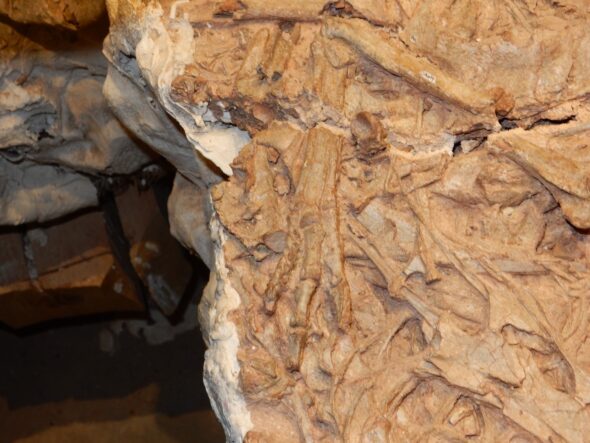
Hospitality
This was a great weekend for hospitality of various forms.
Friday morning, Gary Stradling and I headed up to Ghost Ranch. I had not been to the paleontology museum here in over eight years, and I don’t believe Gary has ever been to it. And my previous visit was for just ten minutes.
I’ll begin with a panorama taken from the high ground southwest of the ranch.

Ghost Ranch is located in the extreme southeast of the Colorado Plateau, in the Chama Basin. To the west, the Colorado Plateau ends at the western margin of the Rio Grande Rift. Gary is determined to understand the stratigraphy here, and I take some time to go over it, as best I understand it myself.
The best place to pick rock beds out is the mesa just left of center in the panorama. Here, let’s get an embiggened view:
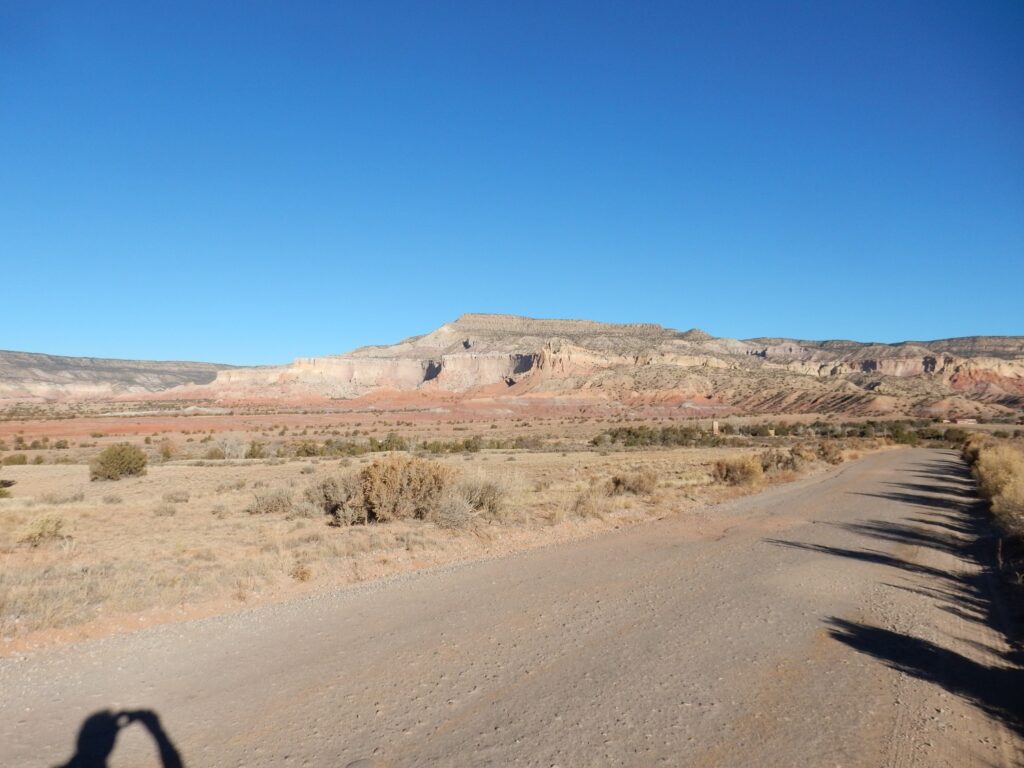
As with almost all images at this site, you can get a higher-resolution version by clicking on the image.
The red beds at the foot of the mesa are Chinle Group. (A group is a set of formations that are related in some meaningful way. A formation is a set of rock beds that share a common set of physical characteristics that distinguish them from the beds above, below, and (at times) to the sides. Formations are the basic unit of stratigraphy, the geological study of when and how rock beds were laid down and their relationships to each other. Think of a formation as a page in Nature’s book of geologic history.) The Chinle Group is late Triassic in age, around 235 to 205 million years old.
The uppermost formation of the Chinle Group here is the Rock Point Formation, which is beds of red siltstone and very fine sandstone. A great many fossils have been found in these beds, including the first big find at Ghost Ranch, the Coelophysis Quarry (also known as the Whitaker Quarry), in 1947. The Coelophysis Quarry contained over a hundred fossilized skeletons of Coelophysis bauri, an early dinosaur. These mass kills are thought to be a consequence of flash floods sweeping up entire packs of this species.
Above the red Chinle beds, the lower pinkish cliffs are Entrada Formation, which is Jurassic in age (175 to 165 million years old). There is a gap of at least 30 million years between the Chinle Formation and the Entrada Formation — a profound regional unconformity. A similar gap is found throughout the western United States and is interpreted as a period of erosion (the J-2 discontinuity) that, in the Chama Basin, stripped away any rock deposited after the Chinle Formation.
The lower cliffs are capped by a thin gray set of beds. This is the Todilto Formation, which is limestone and gypsum laid down in a saline flat or marsh around 164 million years ago.
The slopes above the Todilto Formation are Summerville Formation (163-157 million years old) and Morrison Formation (156-146 million years old). If you click for the full-resolution image, you can make out the boundary between the darker brown Summerville and the lighter Morrison on the prominent slopes just left of center. Stratigraphers love to argue about formations; there a school of thought (with some good arguments on their side) that the Summerville Formation does not actually extend to this area, and these beds should be called the Beclabito Formation. There’s also a debate whether the lowermost sandstone beds of the Morrison Formation should be assigned to their own formation, the Bluff Sandstone.
Just below the cap of the mesa are beds of the early Cretaceous Burro Canyon Formation (early Cretaceous, 145 to 100 million years old). These are difficult to distinguish from the overlying Dakota Formation.
The uppermost cap of the mesa is a thick sequence of sandstone of the Dakota Formation. This is a Cretaceous formation 100 to 95 million years old.
Lots of history in these beds. Most are likely a series of snapshots, recording brief intervals of deposition across the time range they nominally represent.
We find we have arrived an hour too early; the museum does not open until 10:00. We visit the bookstore, buy a couple of items, and look at some of the signage outside, which gives a bit of the history of the area. There is some beautiful fall foliage wrapped around a rock with a bird statue.
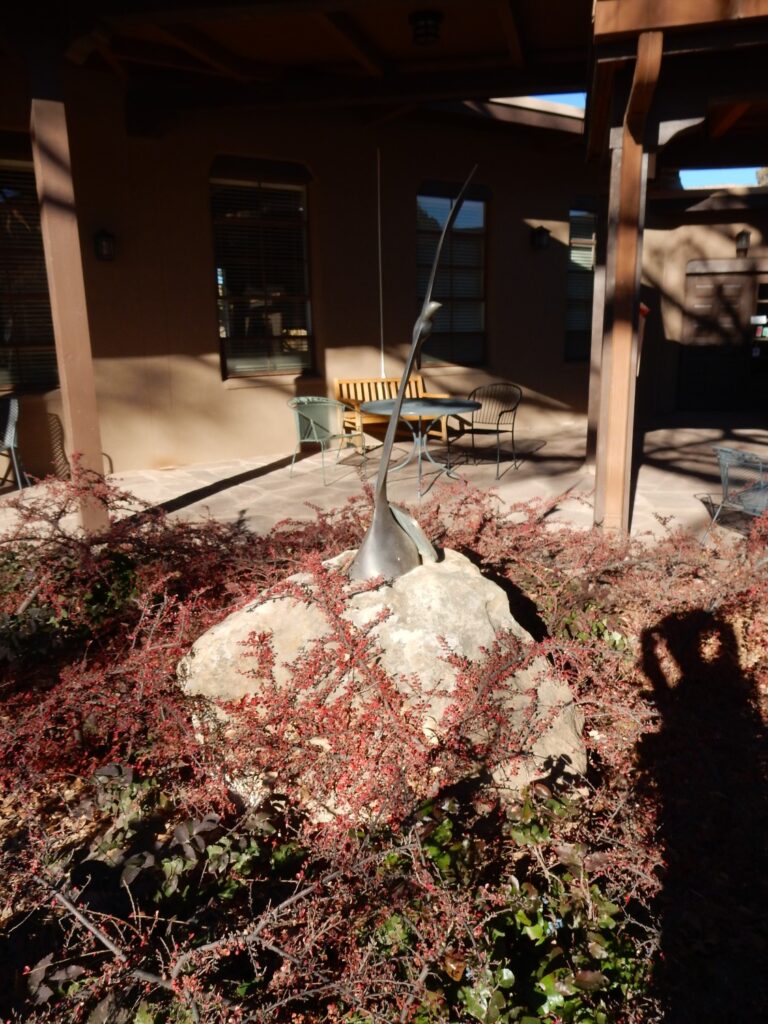
Chimney Rock north of the headquarters.
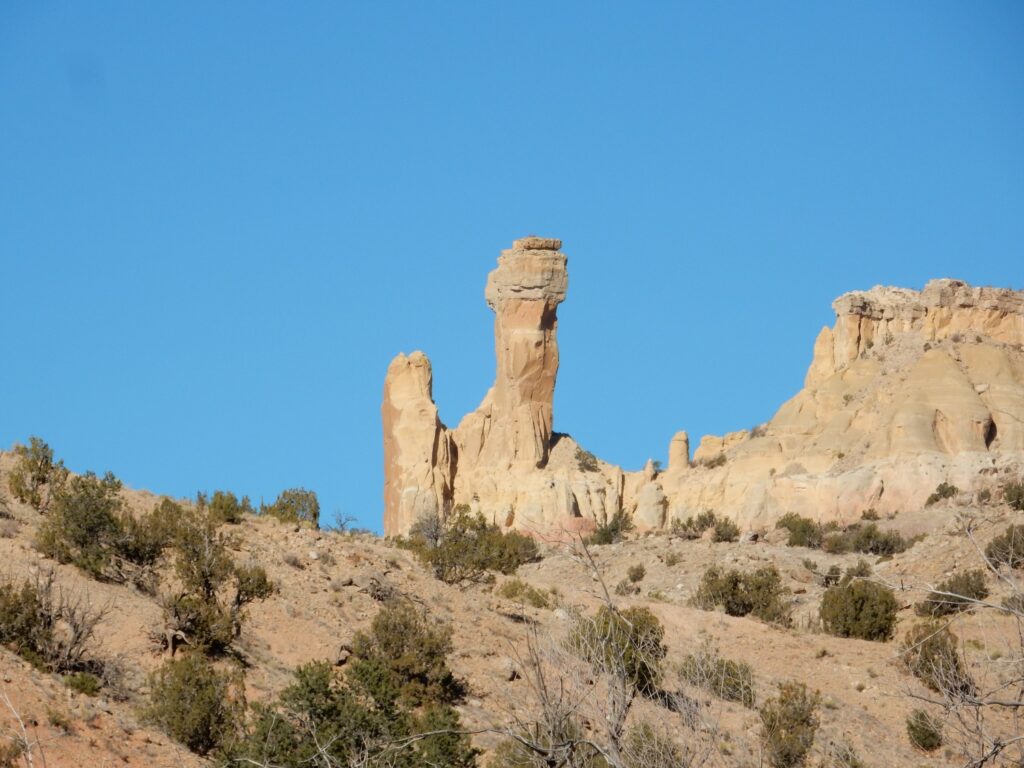
The rock pillars are eroded out of Entrada Sandstone, with a capping block of Todilto Formation.
We arrive at the museum. After a few moments, the onsite paleontologist, Gretchen Gürtler, arrives and lets us in. She is incredibly accommodating, turning our visit into one of the best trips Gary and I have been on.
There are actually two museums adjacent to each other here: the Florence Hawley Ellis Museum of Anthropology and the Ruth Hall Museum of Paleontology. We first visit the anthropology museum, which honors one of the first women to receive a Ph.D. in anthropology. Dr. Ellis and her students discovered a large cache of intact ceramic pots in a lava field north of Ghost Ranch in 1971, towards the end of her career. These apparently were left by the Gallina culture, which flourished north of the Jemez from 1050 to 1300, but which seems to have collapsed due to severe droughts. Wikipedia informs us that these people carefully cleaned up their homes before leaving for an uncertain future. Sadly, we are also informed that most of the human remains from this time died a violent death.
The displays show many artifacts of the Gallina culture, but span the entire time interval from the paleo-Indian era, over 10,000 years ago, through the modern era, with some impressive displays of modern Pueblo art. One display contrasts a pre-1870 blanket intended to be worn, which used coccineal as its red dye, with a post-1870 rug dyed with aniline dye. It turns out that floor rugs are a modern innovation produced for trade; native Americans did not traditionally use woolen cloth as floor coverings.
We then move to the paleontology museum, and, to our delight, Gretchen invites us to see her workshop. This is a real treat.
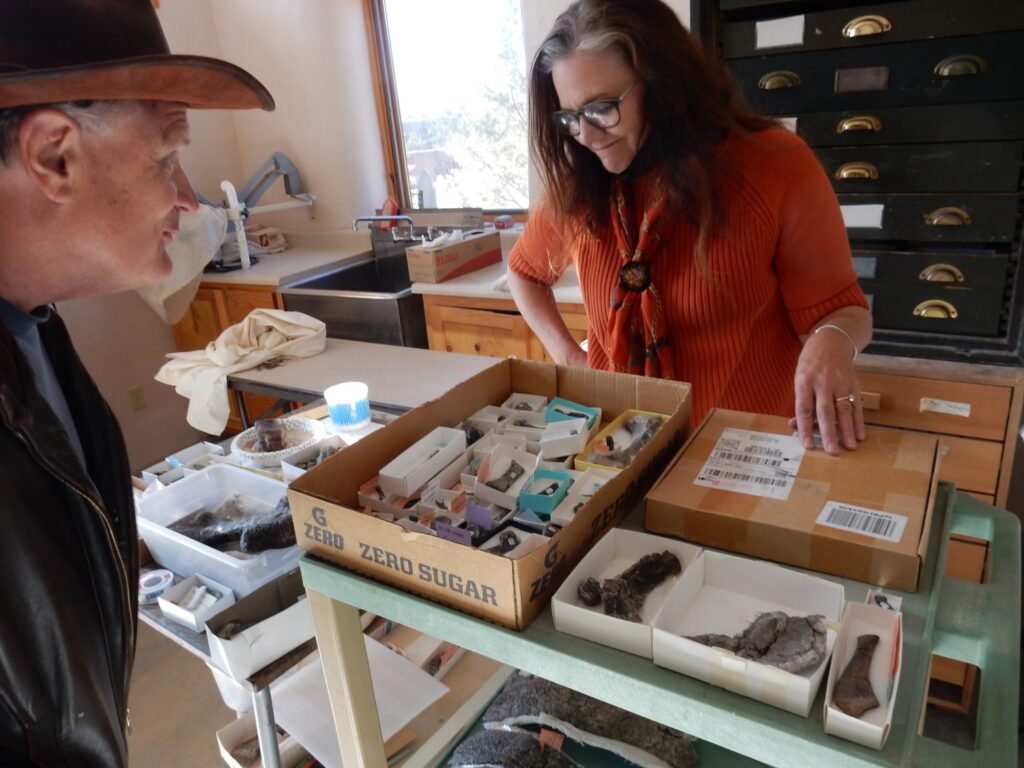
It’s clear Gretchen loves her work and is delighted to show it off. The Ruth Hall Museum is a good place for that; as we’ll see shortly, the museum is set up specifically to let visitors interact with paleontologists at work.
Some of the good stuff.
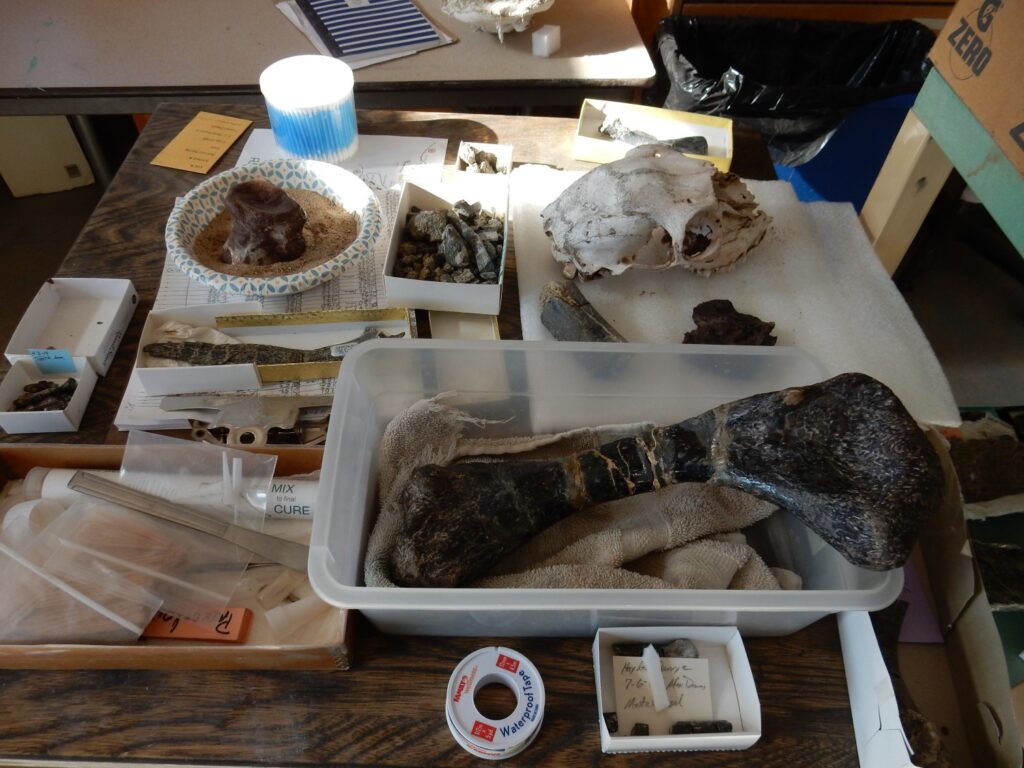
I am kicking myself that I don’t remember what the big bone in front is; possibly an aetosaur femur? An extinct order of heavily armored reptiles. There are a number of scutes (bony armored skin plates) here; I was sure I took a photograph, but none were on my camera when I got home. You can see some at the very bottom of the previous photo, on the lower shelf of the cart.
The modern animal skull at upper right is for educating students. It is light and porous, in contrast with fossilized bone, which is dense and heavy due to permineralization, the deposition of minerals such as silica or calcite from groundwater which preserves bony fossils. Gretchen shows us some relatively young fossils (Pleistocene, less than three million years old) that are partially permineralized, showing how the process progresses.
Here is a slab that is currently being worked on.
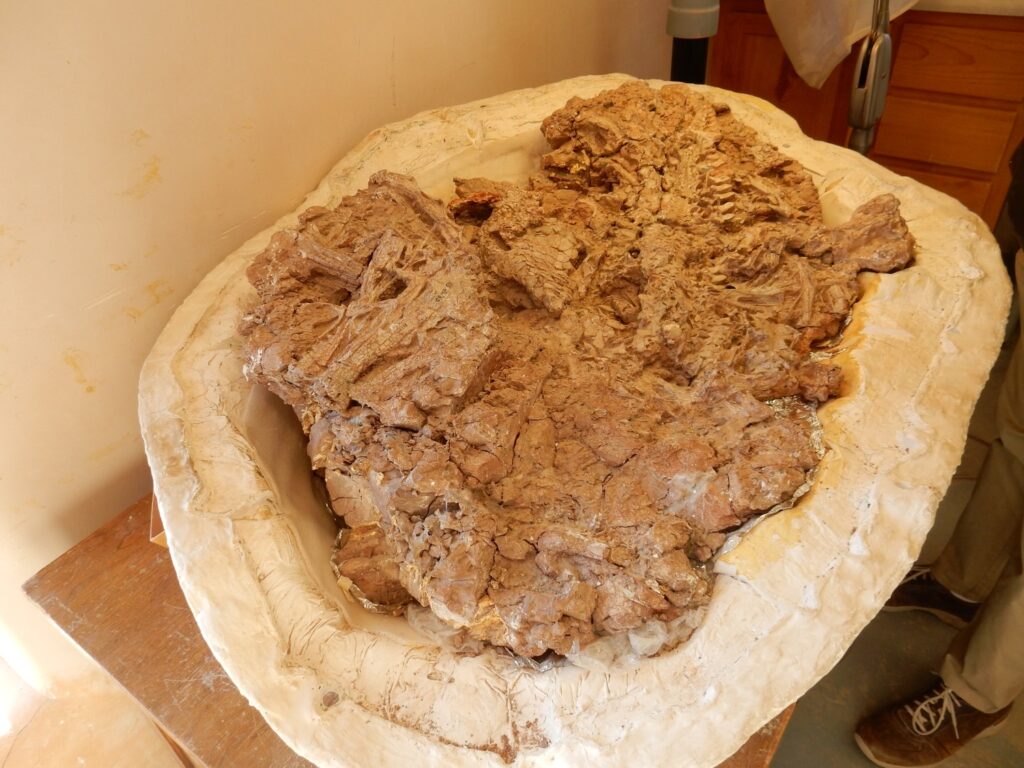
This was part of a 12-ton slab originally taken from the Coelophysis Quarry. This slab yielded the first complete fossils of a strange swimming reptile, Vancleavea. There are remains of at least three animals in this piece of the slab,.
Close view of the slab.
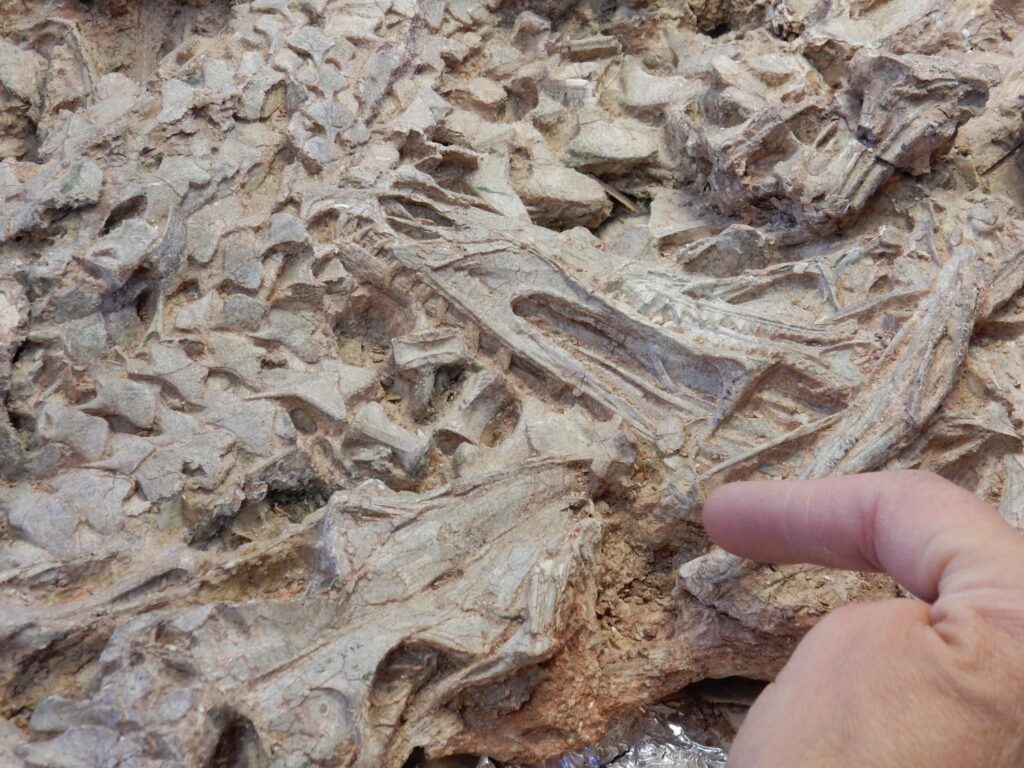
Gretchen is pointing at a skull of Vancleavea at lower left. The skull is missing the lower jaw and we’re looking at the underside of the skull (the palate). You can see the orbits (the eye sockets). At upper left are scutes from the animal’s skin; these overlapped somewhat like fish scales, or like a suit of scale mail. Which is pretty much what they were for this animal.
A more complete skull lying on its side.
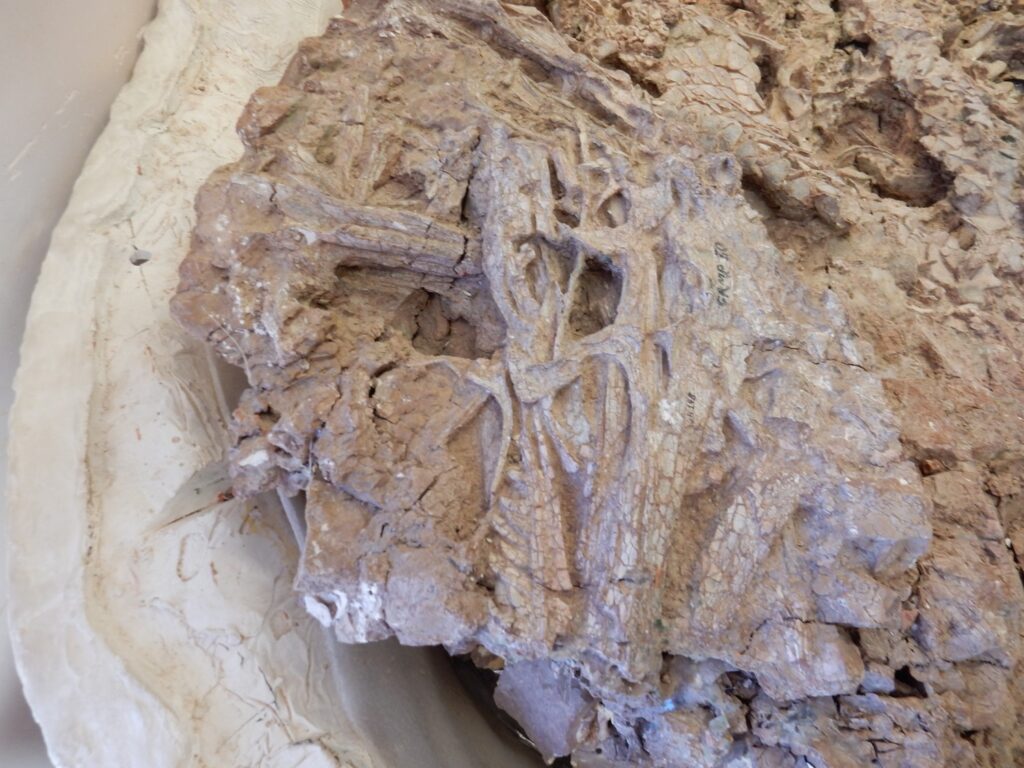
You can see an eye socket just above and to the right of the center of the photograph. The upper jaw extends downwards, with teeth visible.
The whole slab from a different angle.
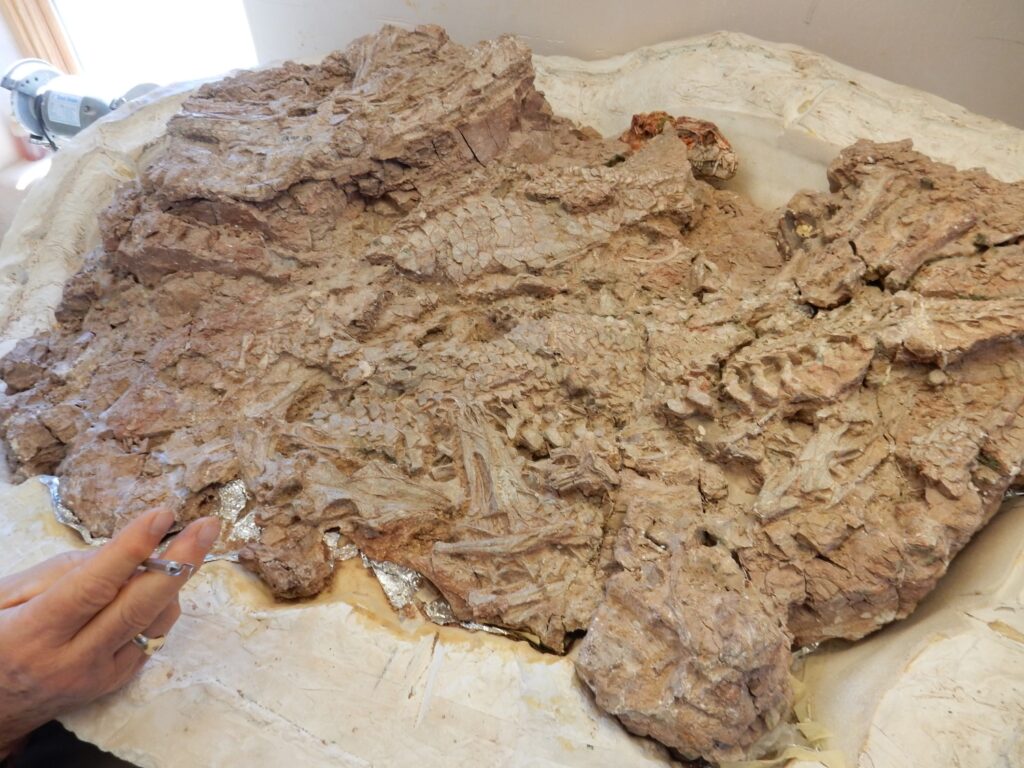
You can see several patches of scutes, and a set of vertebrae extending to the right.
This slab has been worked on for almost two decades. It takes amazing patience to tease out all that we can learn from a fossil slab like this one.
We move into the main museum hall.
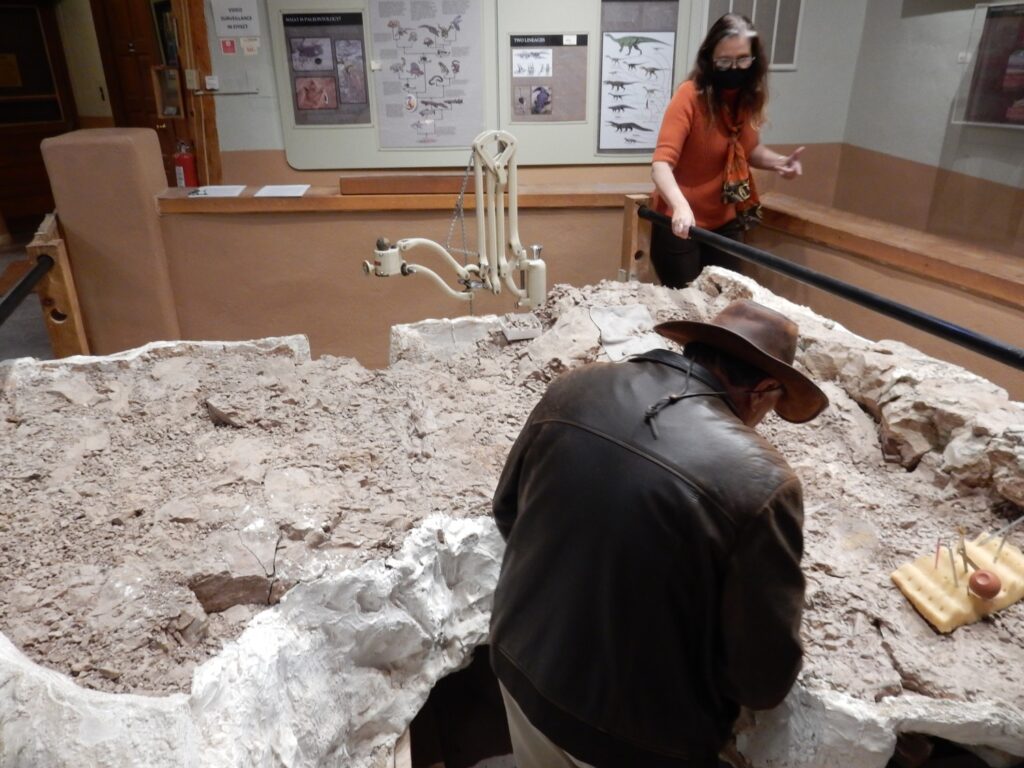
The museum prides itself on the close interactions it promotes between visitors and the paleontologist and students. Visitors can gather around the rail and watch the paleontologist working on the slab and ask questions. It’s really a rather neat setup.
Prized specimen of Coelophysis
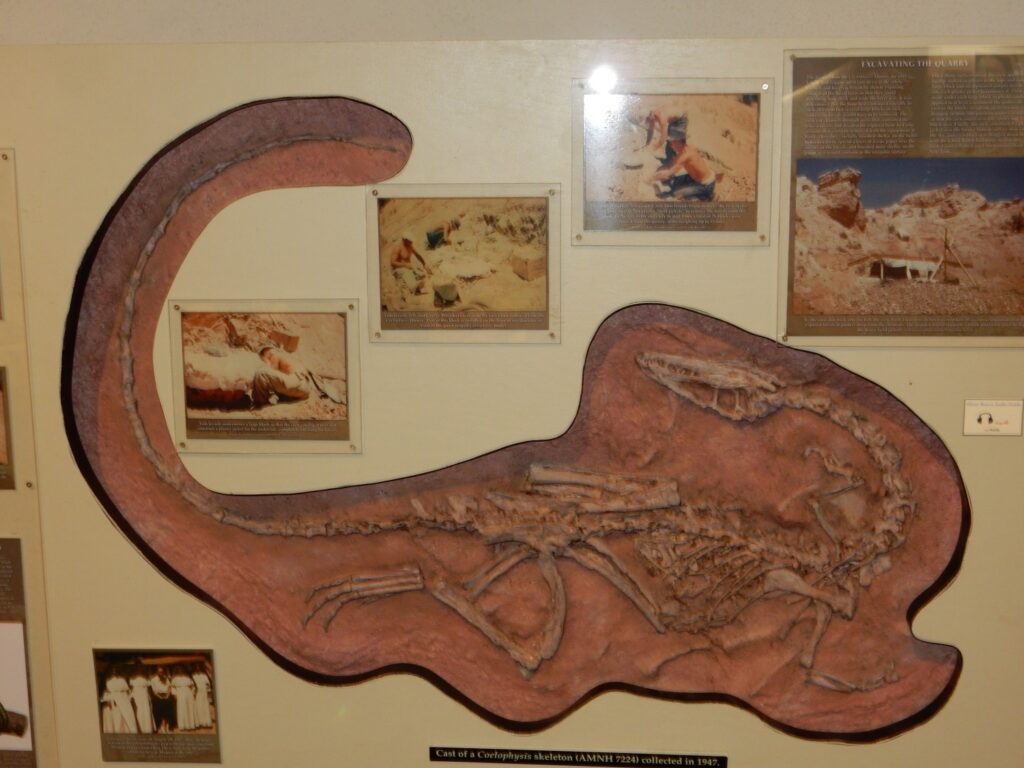
This is a superbly preserved (and prepared) skeleton of a single animal. Coelophysis was an early dinosaur, likely bipedal, carnivorous, and living in packs. It has been found around the world, but the specimens at Ghost Ranch were the first complete fossils.
Notice how the head is curved way back and the tail is likewise curved upwards. This is the result of tendons shrinking after the death of the animal, which pulled it into an unnatural position. The head would have been held well forwards and the tail almost horizontal in life. The tendons apparently sometimes shrink with such force that they can disarticulate the skeleton, that is, pull it apart. For example, the jaw is sometimes pulled off the skull.
Back at the big slab:
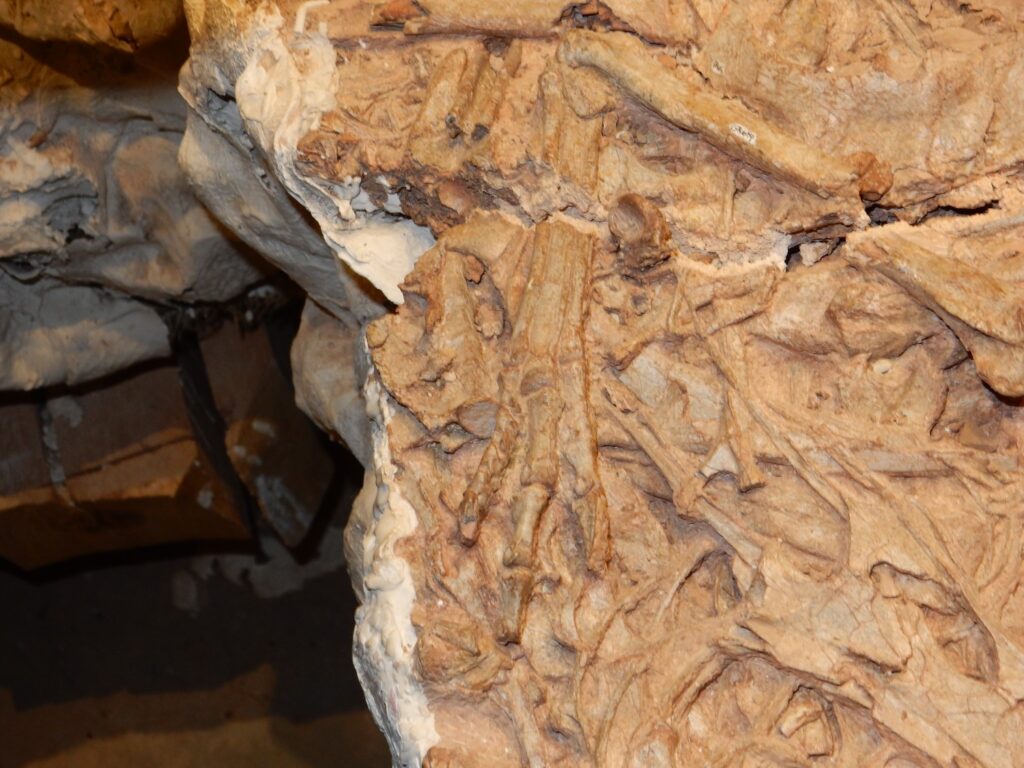
This is the pes (foot) of a fossil skeleton. Since we aren’t always sure whether a fossil creature moved on two feet or four, terms like “rear feet” are avoided; instead, Latin pes is used for the foot at the end of the rear limbs, and manus for the foot or paw or hand at the end of the front limbs. I confess I’m showing off; I started learning these terms only in the last two or three weeks.
Regardless. It’s a wonderfully preserved pes. The bend at top is the ankle, not the knee; this critter had a long foot. Whether it walked on its palms or its toes is not certain. We have no fossilized footprints from this area to give us clues.
The southern Chama Basin has some great history for paleontology. During the “Bone Wars” of 1877-1892, paleontologists Edward Drinker Cope and Othniel Charles Marsh were locked in a bitter rivalry to find and display the best vertebrate fossils from western North America. Bribery, theft, and sabotage were not unheard of. Both paleontologists had teams working quarries around the Coyote area. More recently, quarries have been worked in Canon del Cobre as well as the immediate Ghost Ranch area. Paleontologists are now rather coy about where active quarries are located, except for well-established quarries like Dinosaur National Monument or Jurassic National Monument where visitor access can be adequately controlled. I can’t blame them; fossil poaching is a real concern. One quarry in the Ghost Ranch area, which has been quarried for enough fossils to keep researchers busy for decades, has even been carefully buried and concealed. Someday, researchers will be ready to come back, possibly with improved methods of excavation, to remove additional fossils.
Fossil and reconstruction of Vancleavea, with Gretchen.
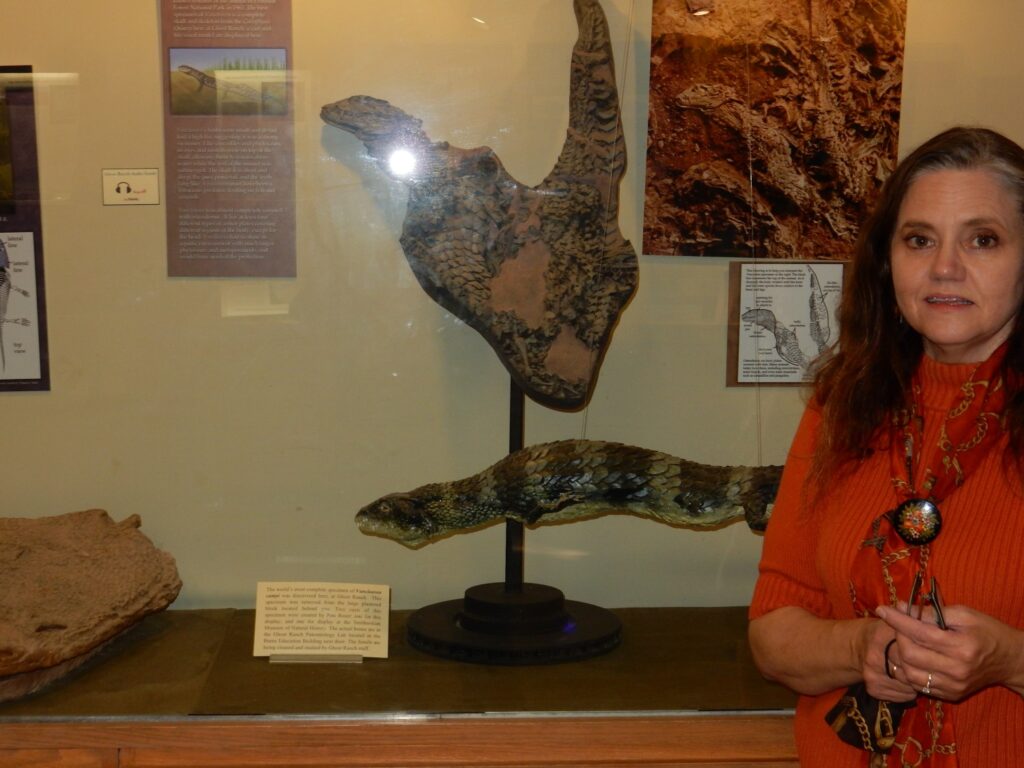
The glass reflects my camera flash. Gretchen very kindly opens the display to let me get a clearer photograph.
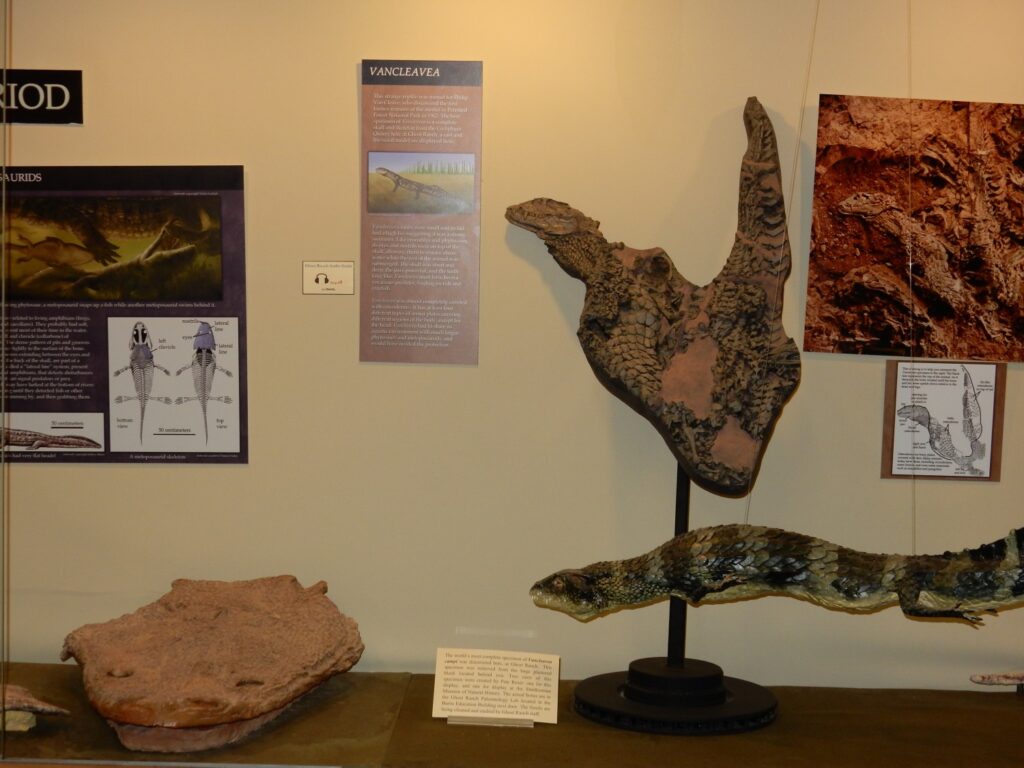
This gives you some idea what a weird critter Vancleavea was: A fishlike swimming reptile covered with armored plates.
At left is a metoposaurid, an early amphibian. Gretchen tells us this was most likely a swamp-dwelling omnivore, filtering out small animals (such as crustaceans) along with plant matter in a rather whale-like manner. Those are eye sockets you see on top. Gretchen thinks that this critter probably burrowed into the mud and went into hibernation to escape a drought … which never ended, but left its remains nicely preserved. This is based on the way the fossil animals have their limbs folded beneath them, in what we might call a fetal position.
This is fun.
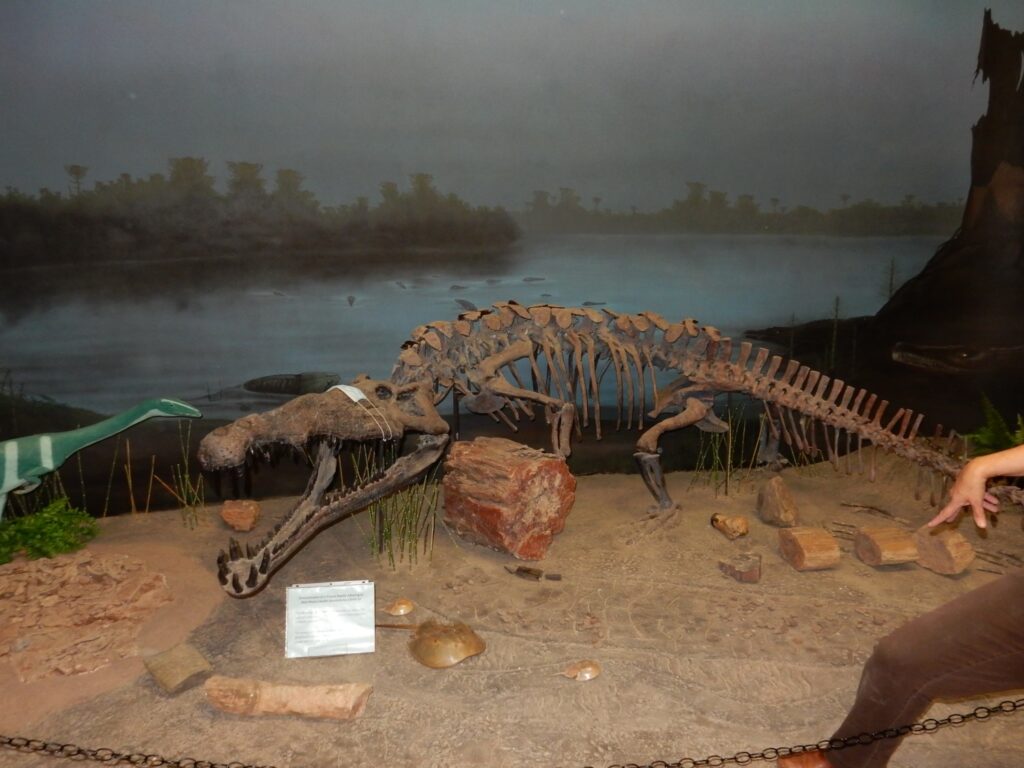
This is a phytosaur, a member of an extinct order of reptiles that looked a lot like crocodiles, inhabited the same ecological niches as crocodiles, but were not actually crocodiles. In fact, they weren’t even that closely related; modern birds and crocodiles are more closely related to each other than either is to phytosaurs. This is an example of what paleontologists call convergent evolution, where unrelated groups occupying similar ecological niches find the same evolutionary solutions and end up looking superficially very similar. Another is brachiopods, which look a lot like clams, but are an entirely different phylum of animal.
The phytosaur is practicing appropriate COVID masking. Yep, those are where its nostrils were. This is one difference from modern crocodiles, whose nostrils are at the ends of their snouts. Either way, the critter can float just below the surface, with only eyes and nostrils showing, waiting for an unwary prey.
Well, and as it turns out: This is actually parts of three phytosaurs. Since fossil skeletons are very often incomplete, it is not uncommon to put together bones from more than one animal to reconstruct the complete skeleton. The trick is being sure they are actually the same species.
Don’t remember what this was.
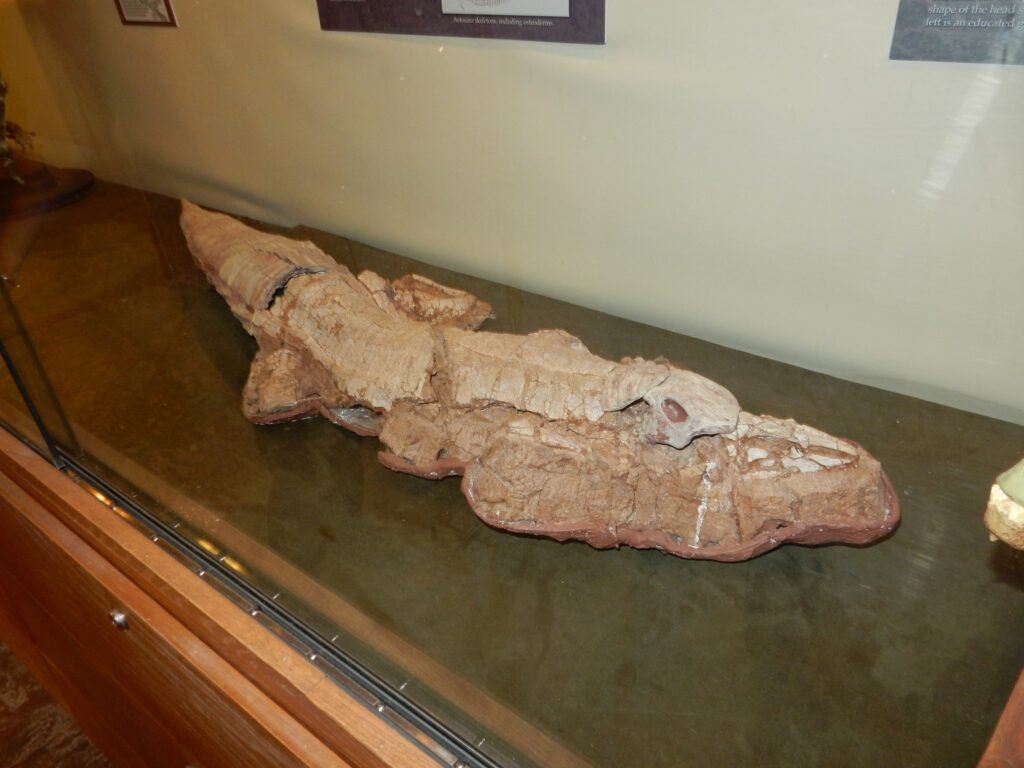
Gary had a family appointment and I had other chores that day, so we had to depart at this point. But it was a wonderful visit and tour, and we hope to have other opportunities for paleontological activities with Greta and the museum.
Yesterday was the annual Earth Treasure Show hosted by the Los Alamos Geological Society. The show is held at the Masonic Temple in Los Alamos in early December.
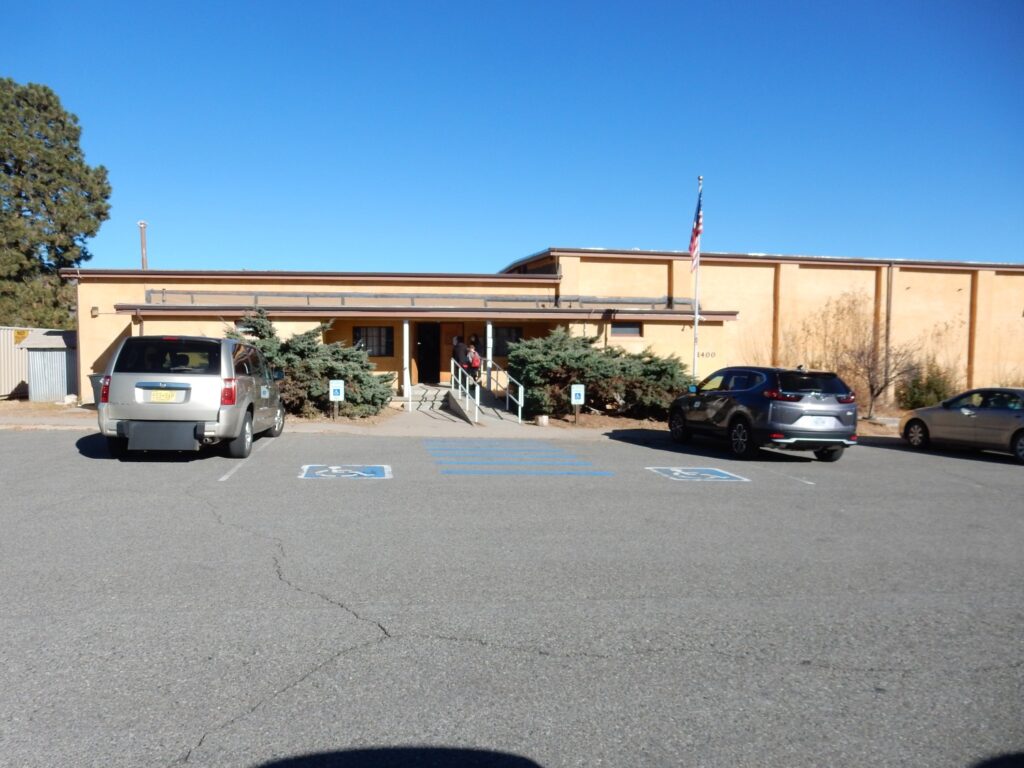
My assignment as a Society member this year was security, but I arrived an hour early and was able to photograph some of the most interesting stuff and do a little shopping.
Front desk.
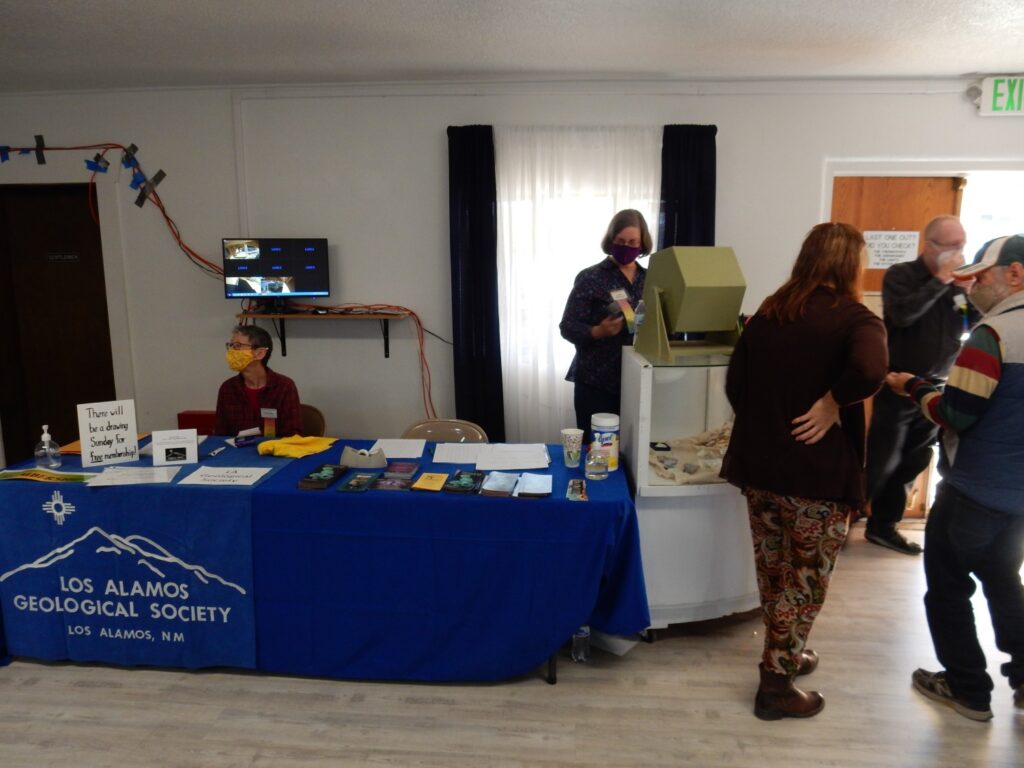
Everyone is expected to sign in — I learned that this was partly as a security measure. However, there is no entrance fee, and you get a raffle ticket for a prize drawing. I also habitually renew my Society membership at the Society desk (at left); I first joined at one of these shows, and it’s just been convenient to renew every year here ever since.
The show is basically in two rooms connected by two corridors. In addition to the sign-in and Society desks, the front room has a cafeteria selling light lunches, the Wheel of Fortune and silent auction activities, the New Mexico Bureau of Geology and Mineral Resources booth, and the first few vendors, who are selling mostly jewelry.
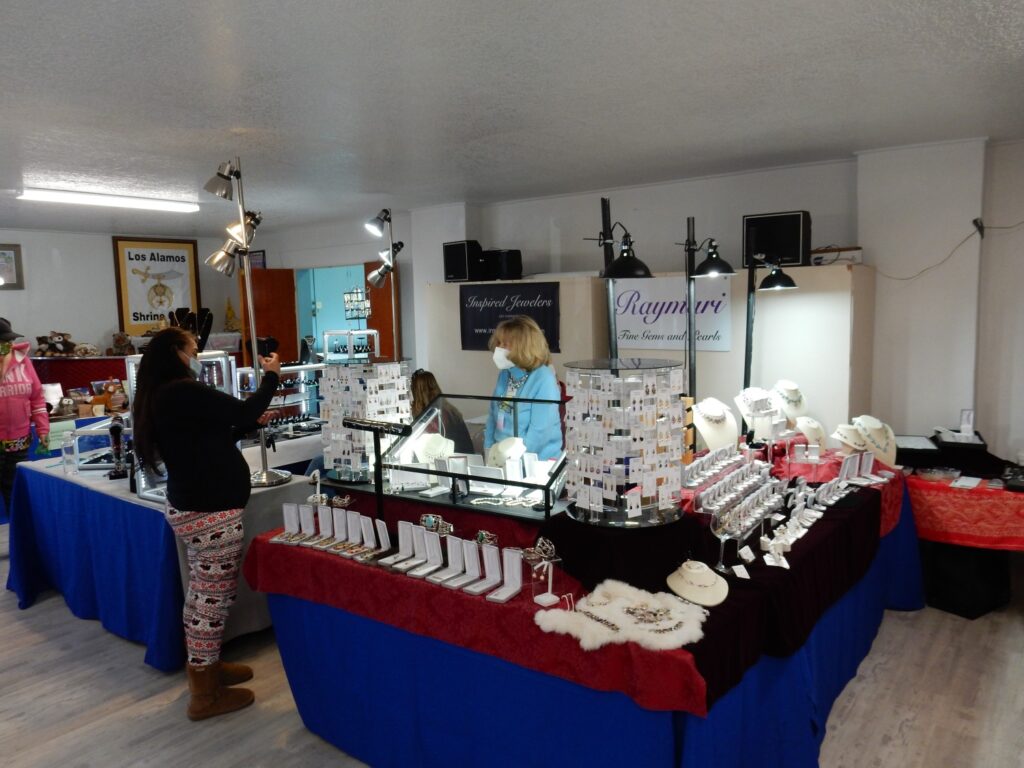
Most of our vendors have come every year I’ve attended, which is a reassuring sign of stability. That they keep coming back indicates the show is a successful venue for them, which is all for the good. I’ve bought a couple of nice things for Cindy from one of the jewelers here, for Christmas, various years.
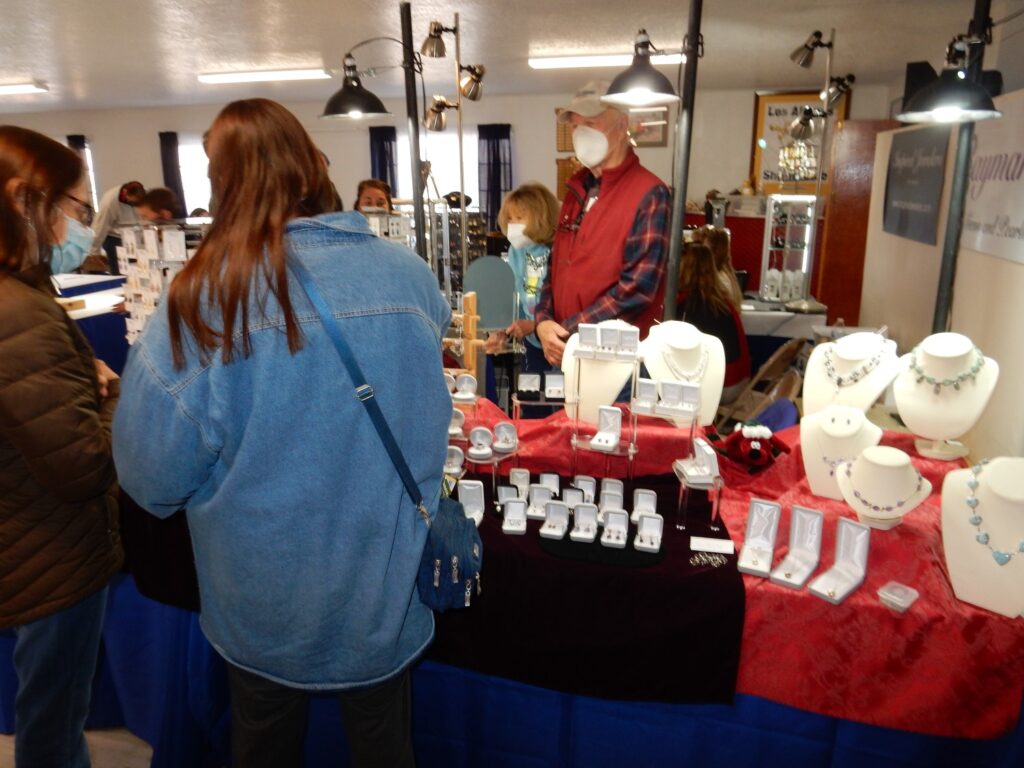
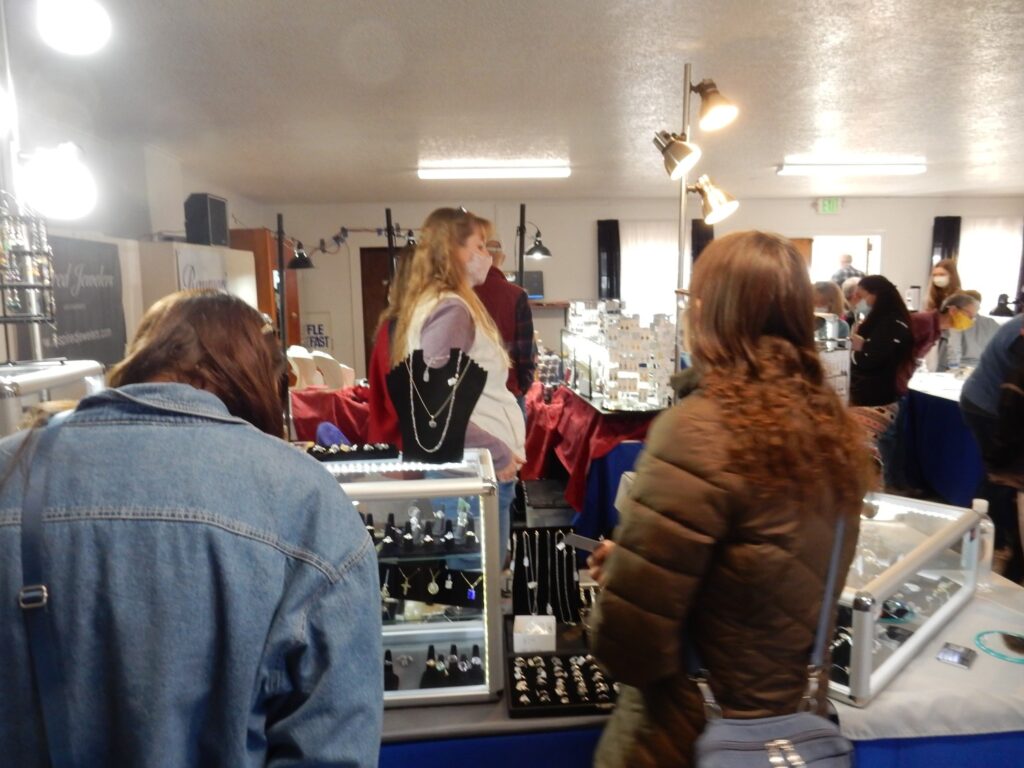
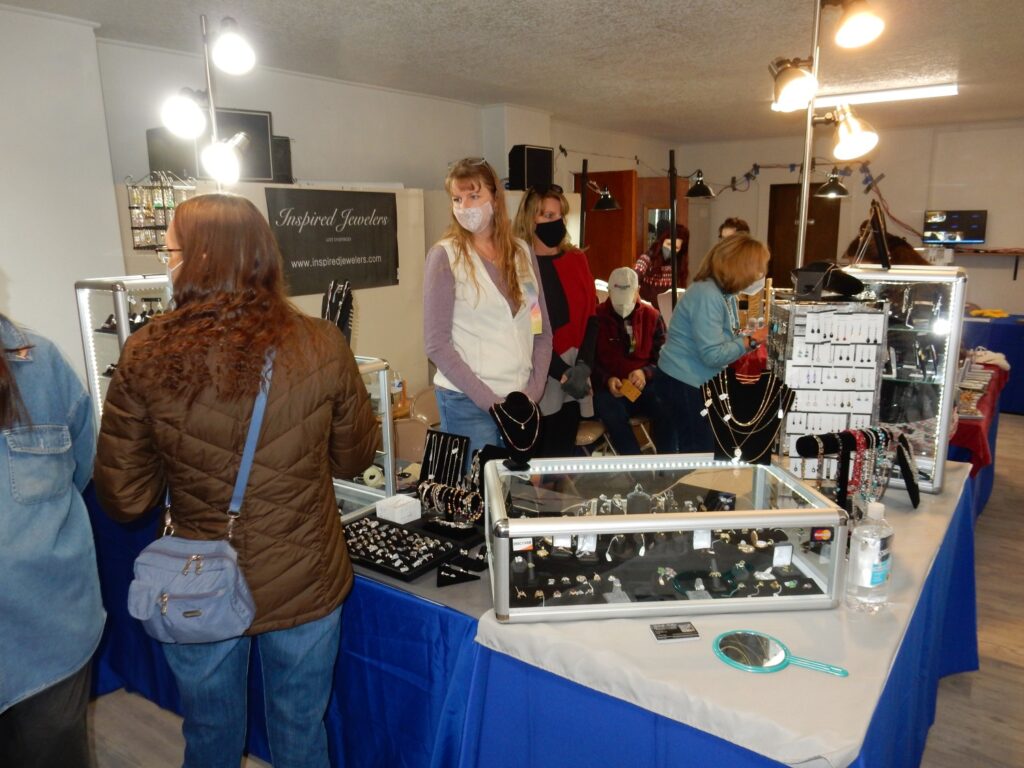
Shari Kelley at the New Mexico Bureau of Geology and Mineral Resources booth.
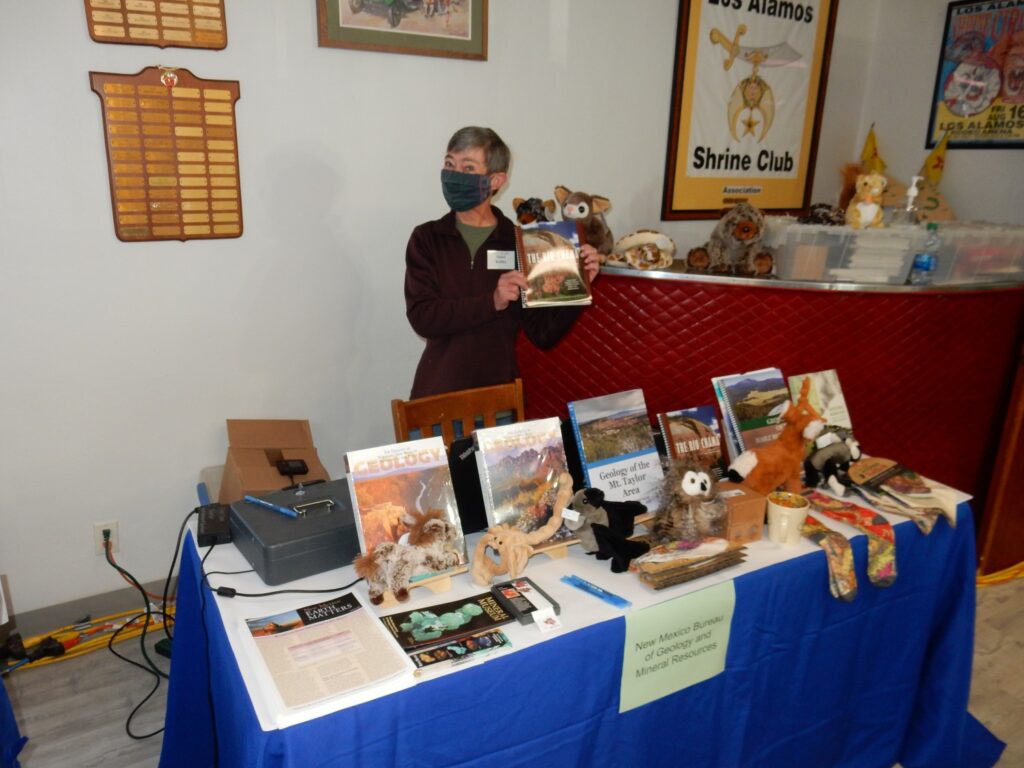
Shari and Rick Kelley are first rate, and so is the NMBGMR, who put out some superb publications. NMBGMR have fairly close ties to the New Mexico Geological Society, of which I am also a member, who run a first-rate field conference most every fall. Alas, the last two have been canceled due to COVID, and apparently this next spring isn’t looking good.
I pick up a book on the geology of the Rio Chama area.
Another vendor:
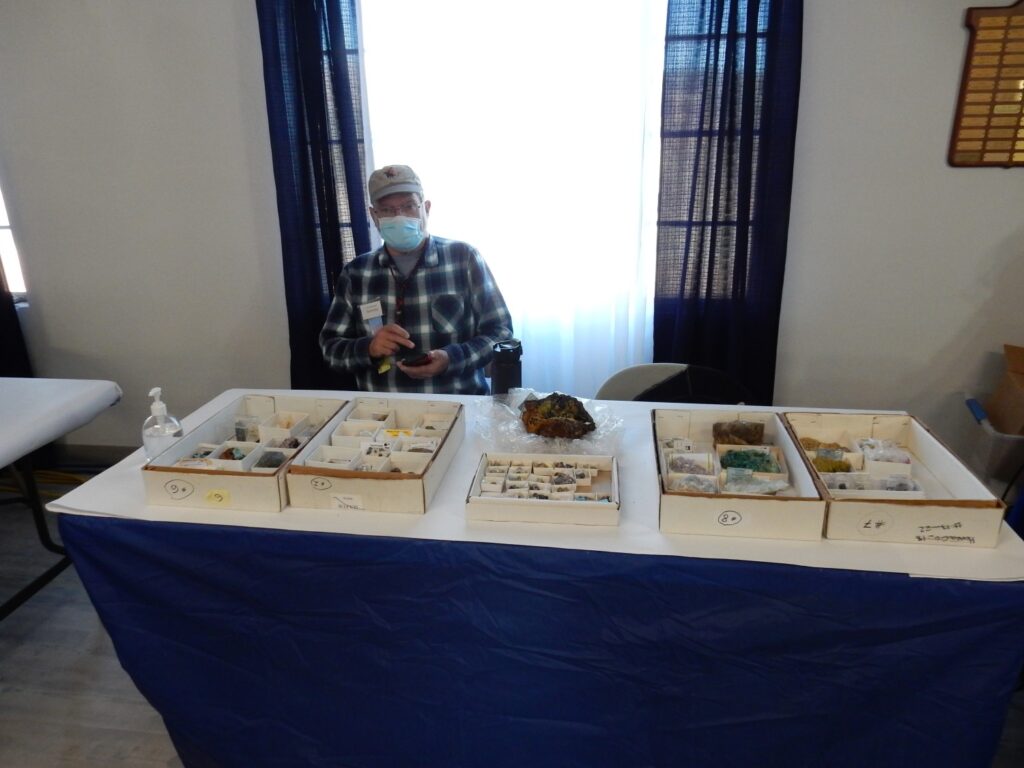
The corridors connecting the two main rooms always have some displays of interesting geology.
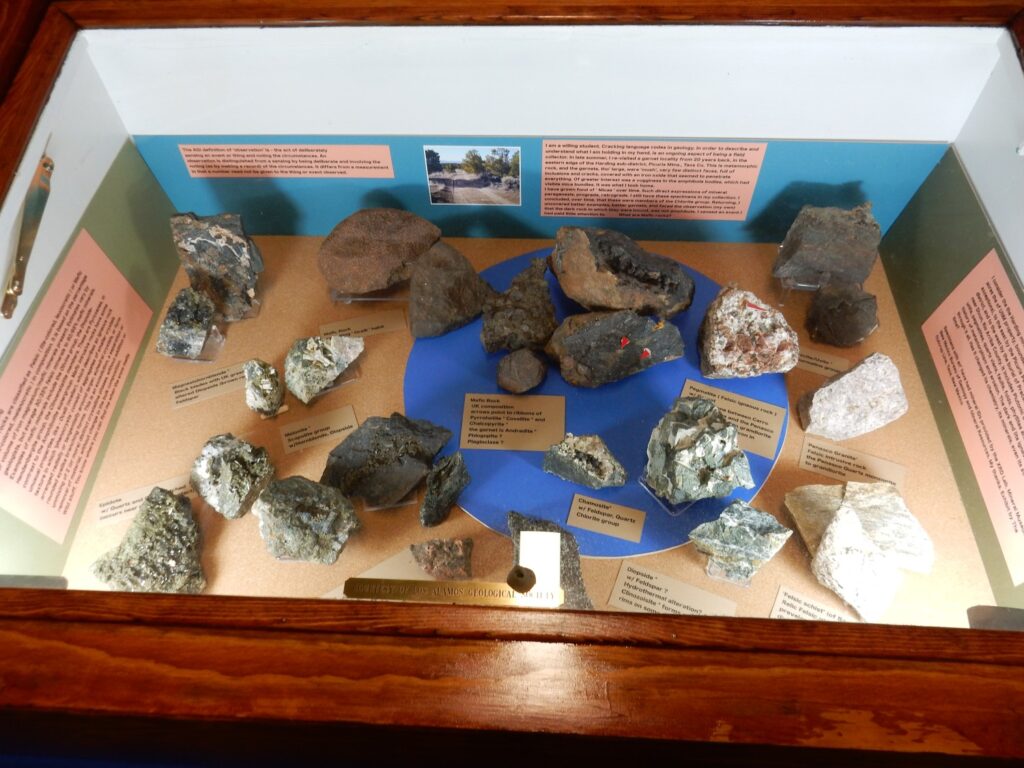
(Clicking for full resolution should allow you to read the placards.)
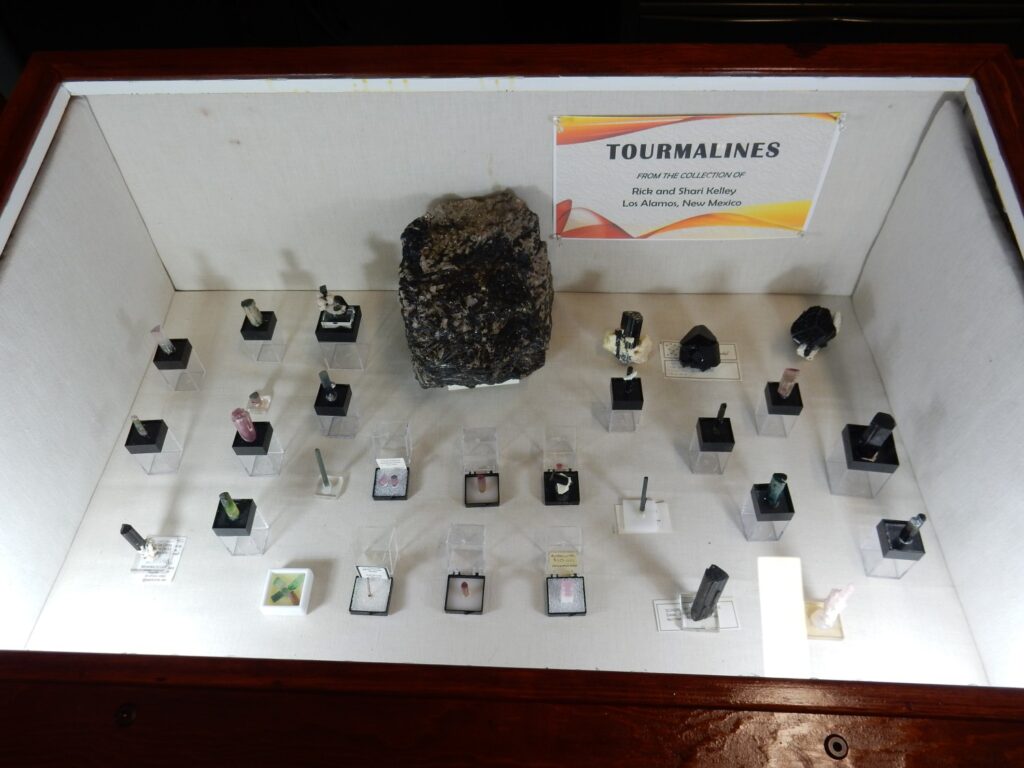
I do envy some of my fellow collectors. I have a wife, three adult children still at home, five cats, a fish tank, and a hungry mortgage to feed, but I try to pick up the occasional budget-friendly nice specimen. I collect in the field when I can as well.
The main display room.

We usually have some very impressive display cases from local museums at one end of the room.
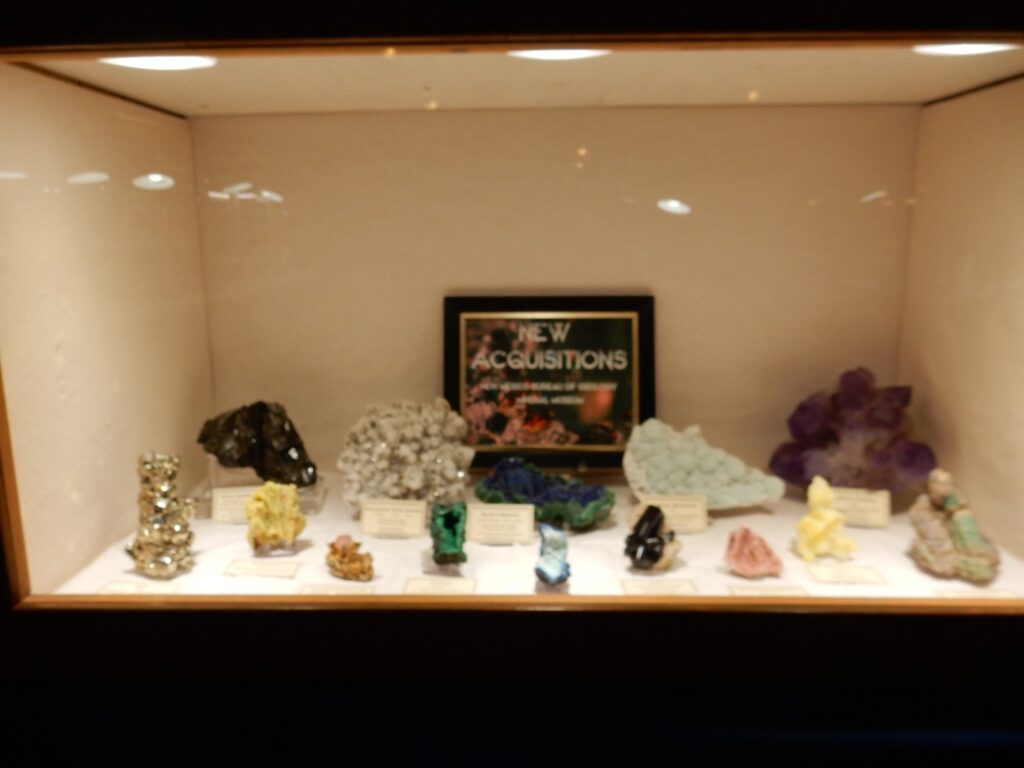
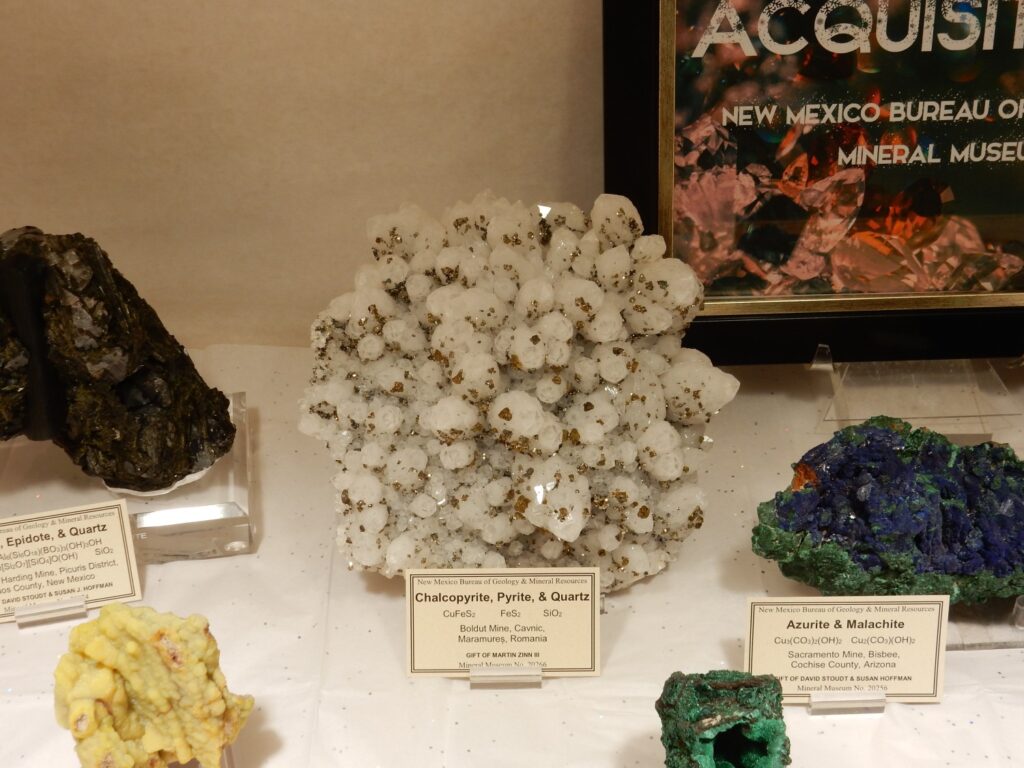
These are quite literally museum pieces. Judging from the material that is on sale elsewhere in the room, I would not be surprised if an item like this was worth several thousand dollars or more. It’s a very impressive cluster of crystals of the sulfide minerals, chalcopyrite, and pyrite, encrusting a spray of quartz crystals. Something like this forms in a hydrothermal vein, where there is an open space in the rock allowing crystals to form over thousands of years from hot hydrothermal fluids. Hydrothermal veins are common; hydrothermal veins with enough room and fluid supply to form something this spectacular are exceedingly rare.
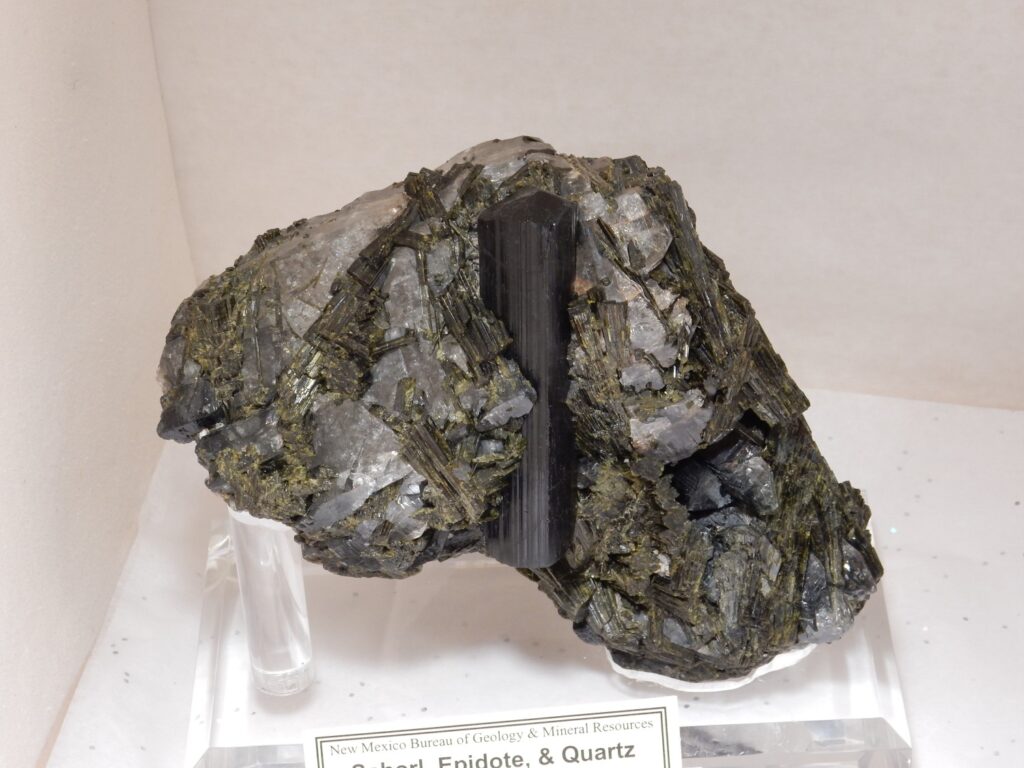
A stunning sample with quartz (transparent) and epidote (green) wrapping a magnificent crystal of schorl, a form of tourmaline rich in iron and sodium. This is from the Harding Mine, which I have visited more than once, but I’ve never found anything this spectacular. Being at the right location is only a small part of finding and collecting great specimens.
Beautiful malachite and azurite.
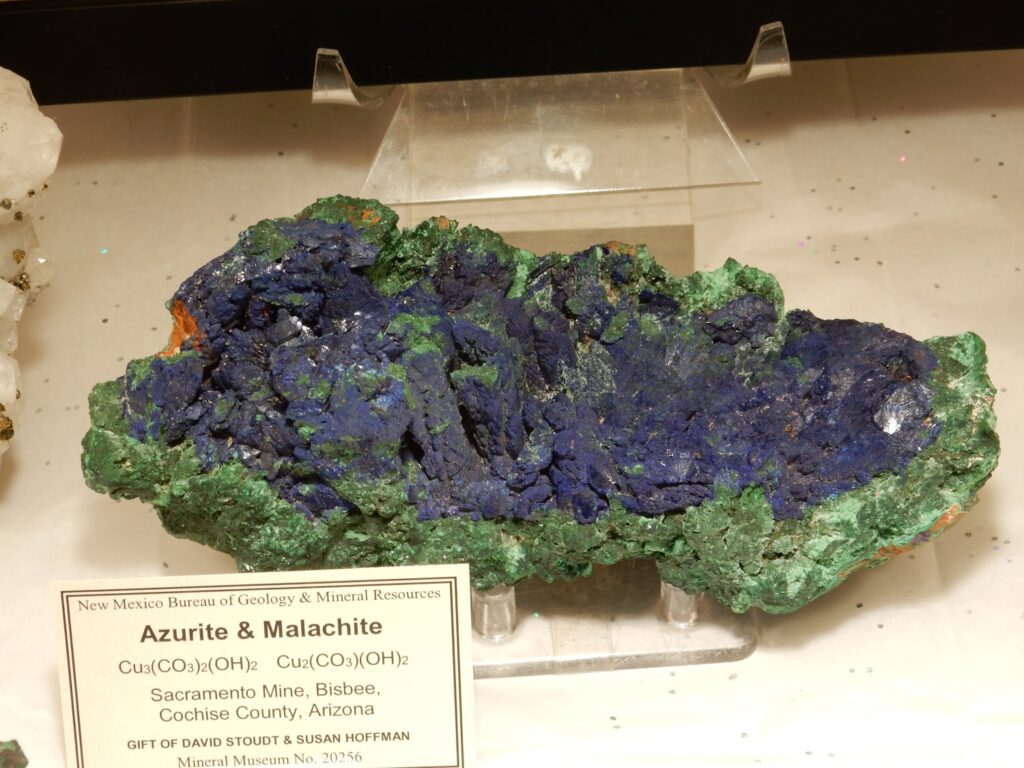
Malachite and azurite are copper basic carbonate minerals. They’re composed of copper, carbonate, and hydroxide ions forming a regular crystal lattice. The two differ in the relative proportions of carbonate and hydroxide, and, over sufficient intervals of time, the blue azurite will tend to convert to the green malachite. You can see how the malachite surrounds a core of azurite here.
Azurite makes a pretty decent blue pigment for painting. It was favored for painting the Madonna’s blue robe in Medieval paintings. That’s long enough that, in some of the painting less well cared for, the Madonna’s robe has turned blue-green. A more stable pigment was lapis lazuli (I saw some samples later) which was also more expensive.
Calcite’R’Us.
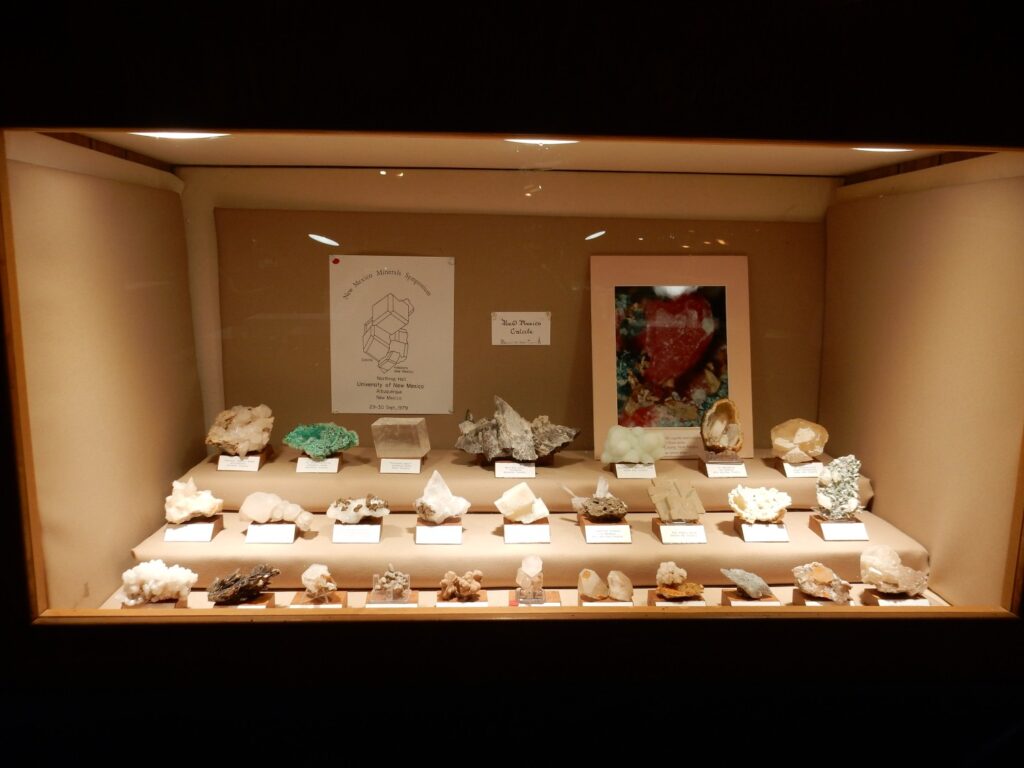
Calcite is a very common mineral — but not calcite crystallized this beautifully. Even quartz, the most common single mineral composition in the Earth’s crust, is valuable when exquisitely crystallized, as I discovered when pricing some superb single crystals later in the day.
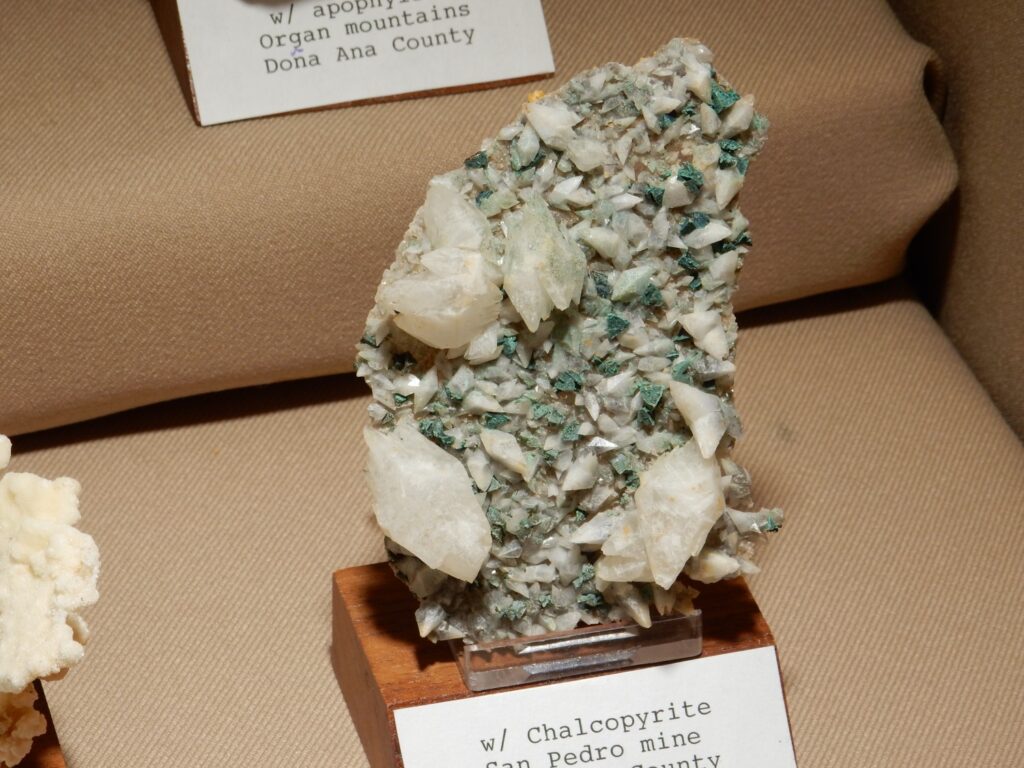
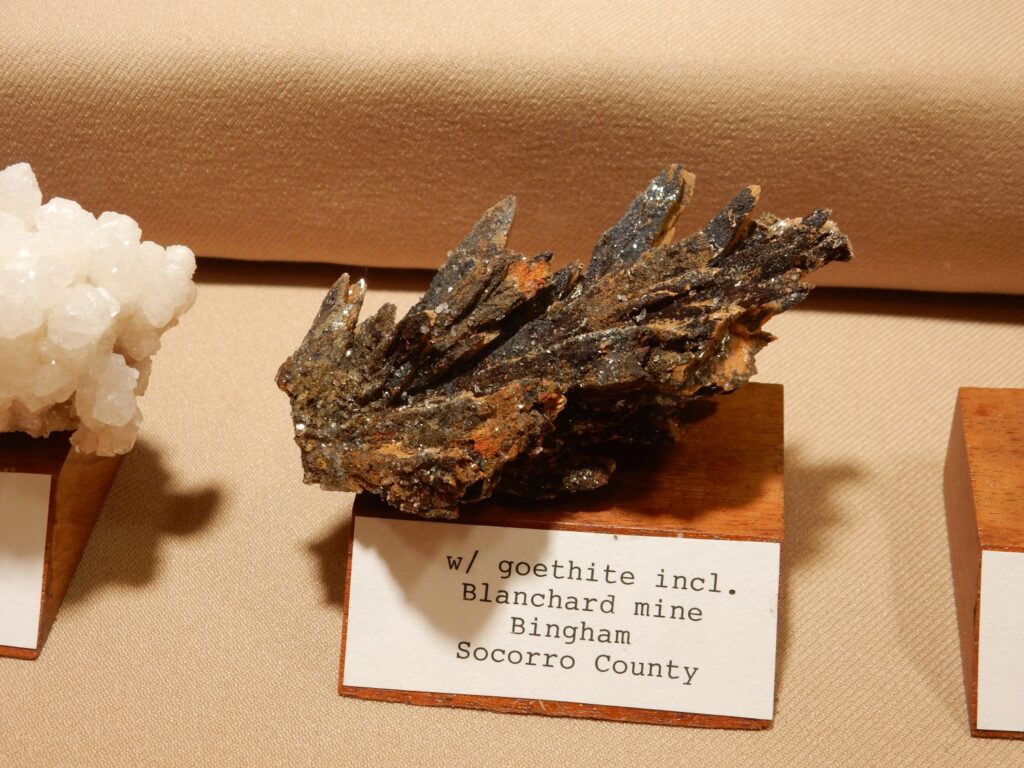
Goethite is a hydrous ferric oxide, formerly an important iron ore. (It’s still extremely widespread, but the concentrations worth mining have all pretty much played out.)
Fluorite.
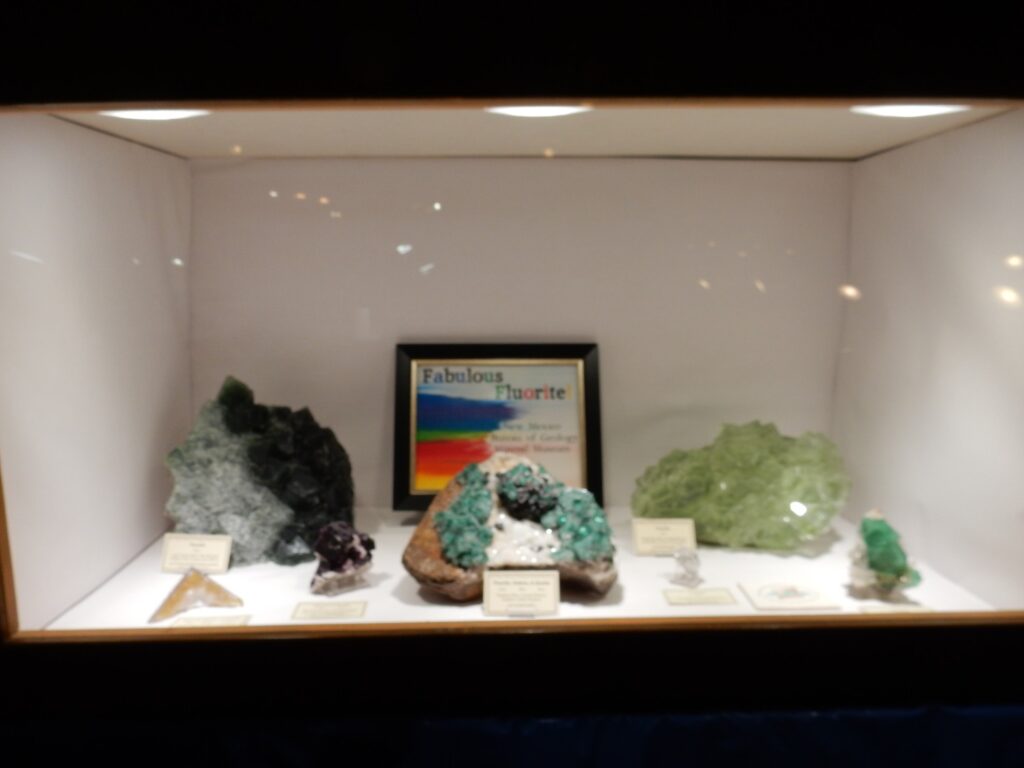
Fluorite is calcium fluoride, a fairly simple compound, which in pure form makes colorless cubic or octahedral crystals. It has a knack, though, for picking up impurities that give it beautiful colors. It forms mostly in hydrothermal veins from fluids enriched in fluoride.
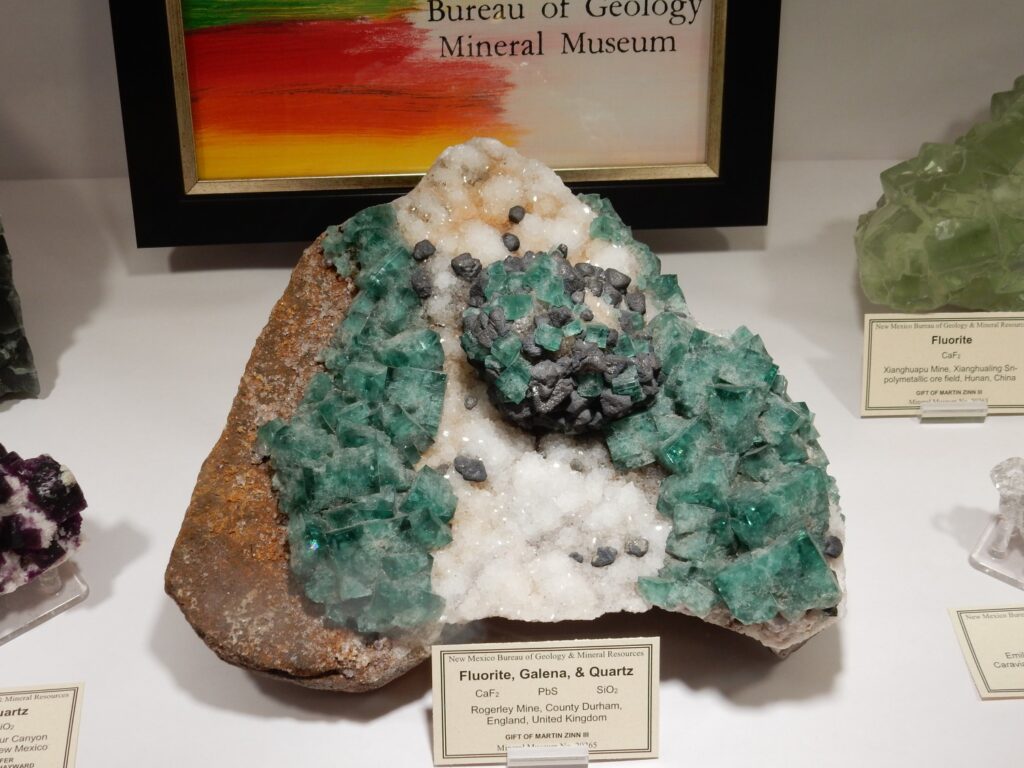
Galena is lead sulfide, another (typically) hydrothermal mineral.
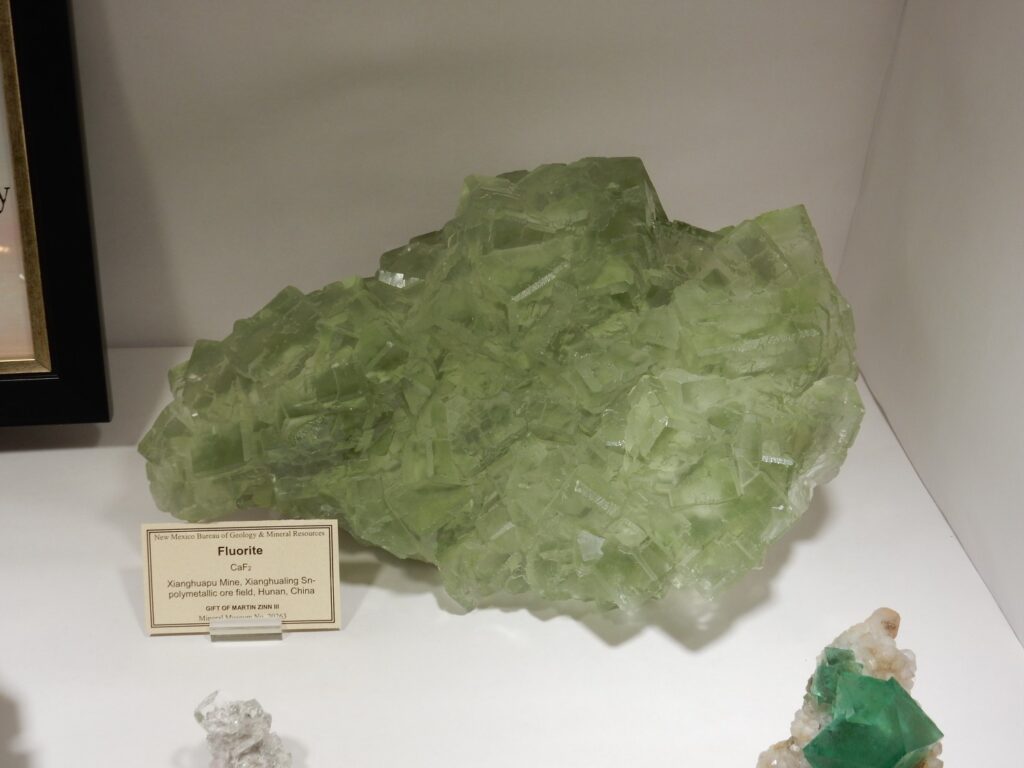
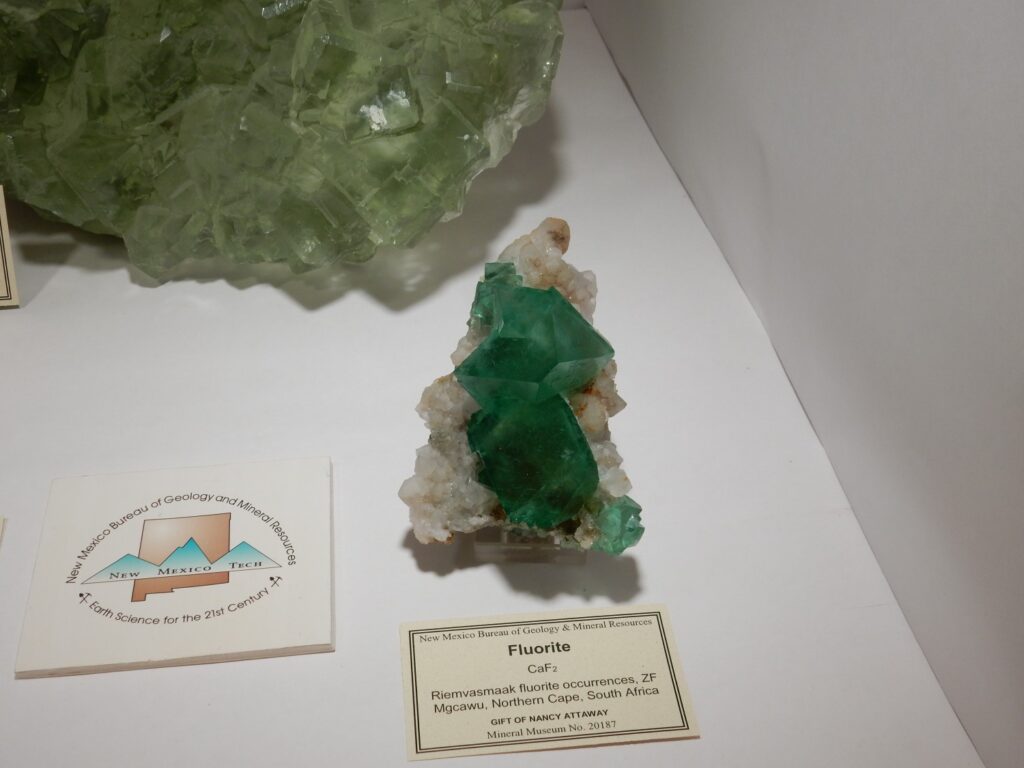
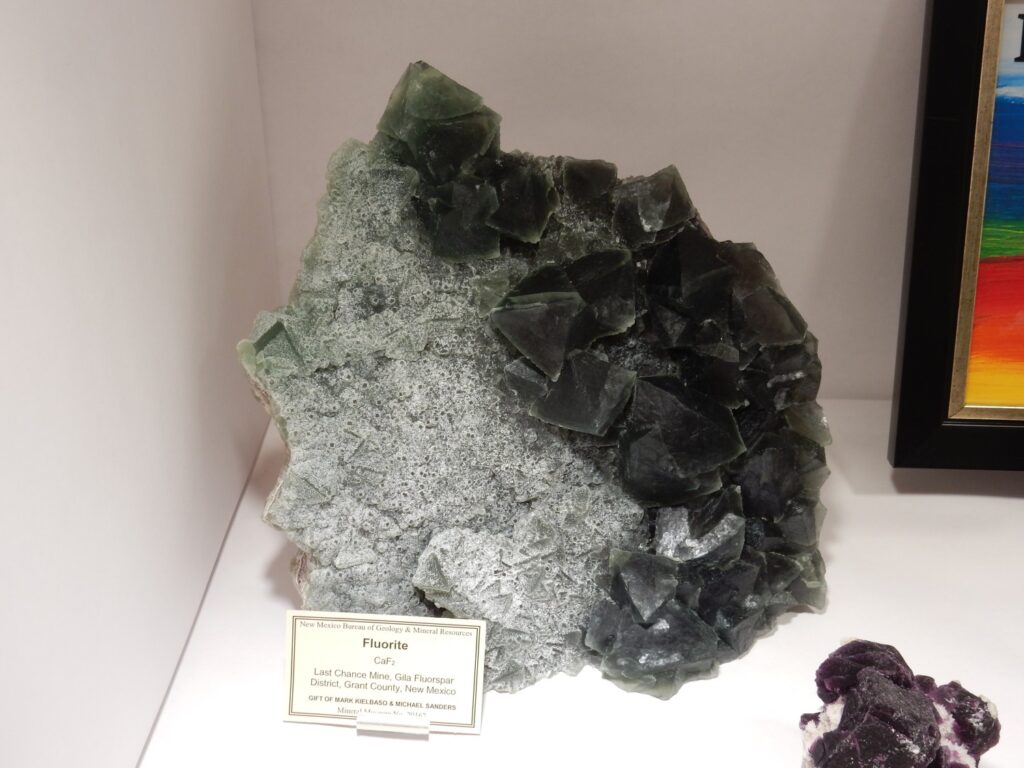
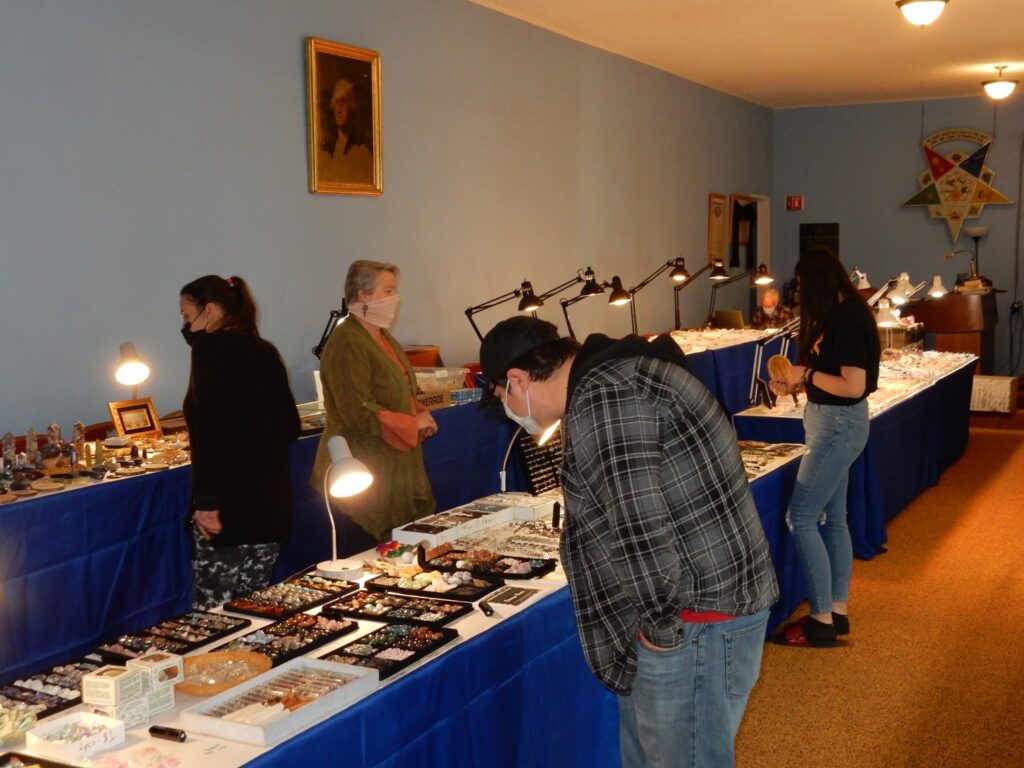
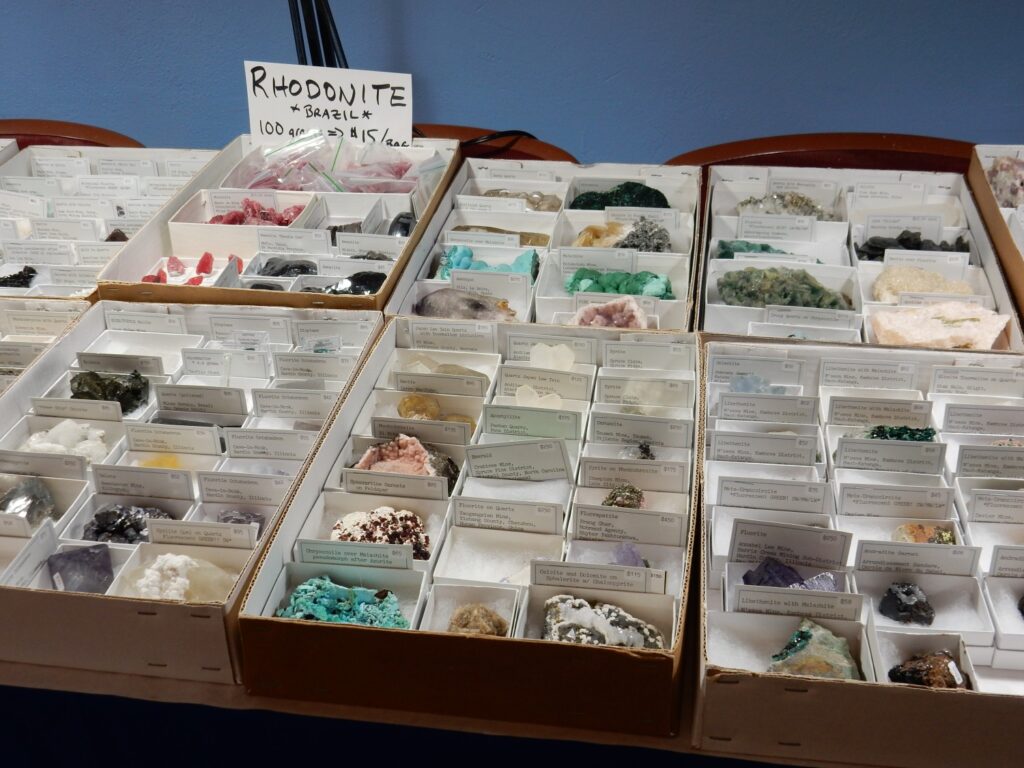
Prices for these are typically $80 on up — hence the need for security.
Beautiful azurite.
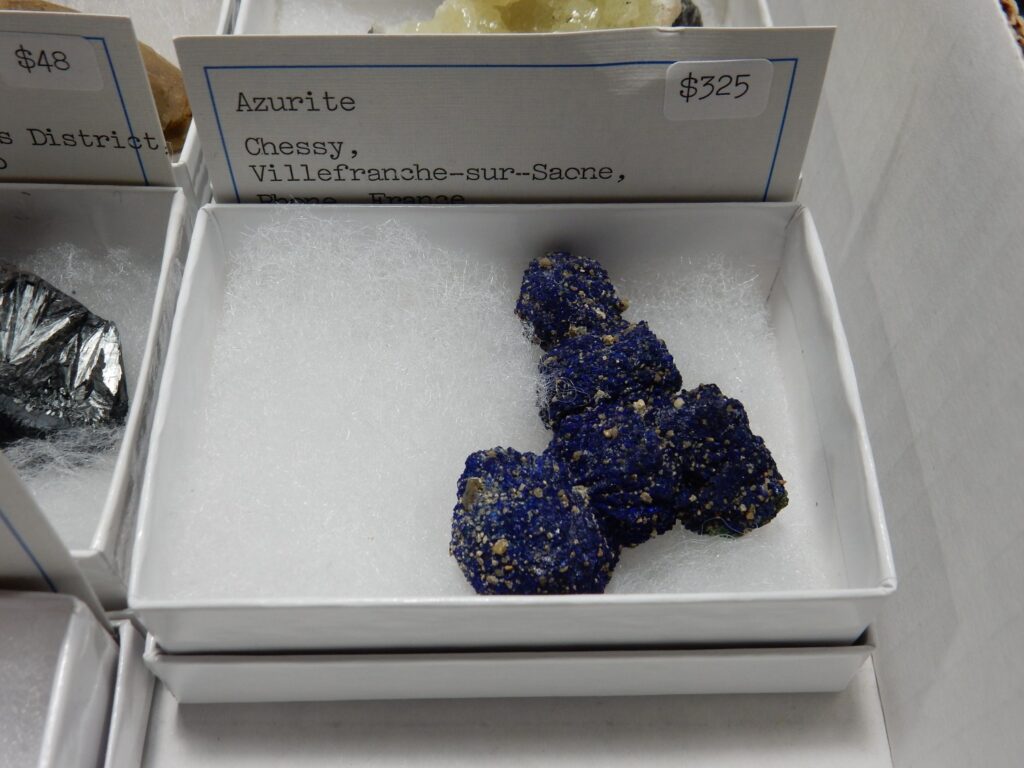
I wasn’t kidding when I guessed that the museum piece in the display was probably worth at least thousands of dollars.
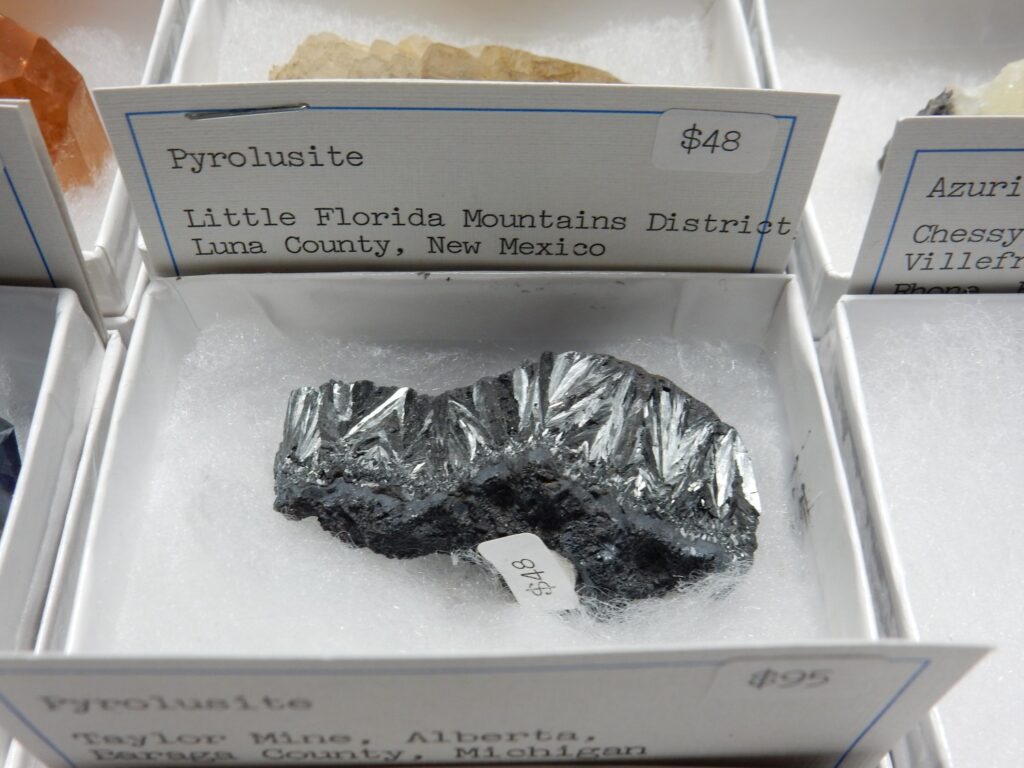
As I noted a moment ago, even common quartz is valuable when spectacularly well crystallized.
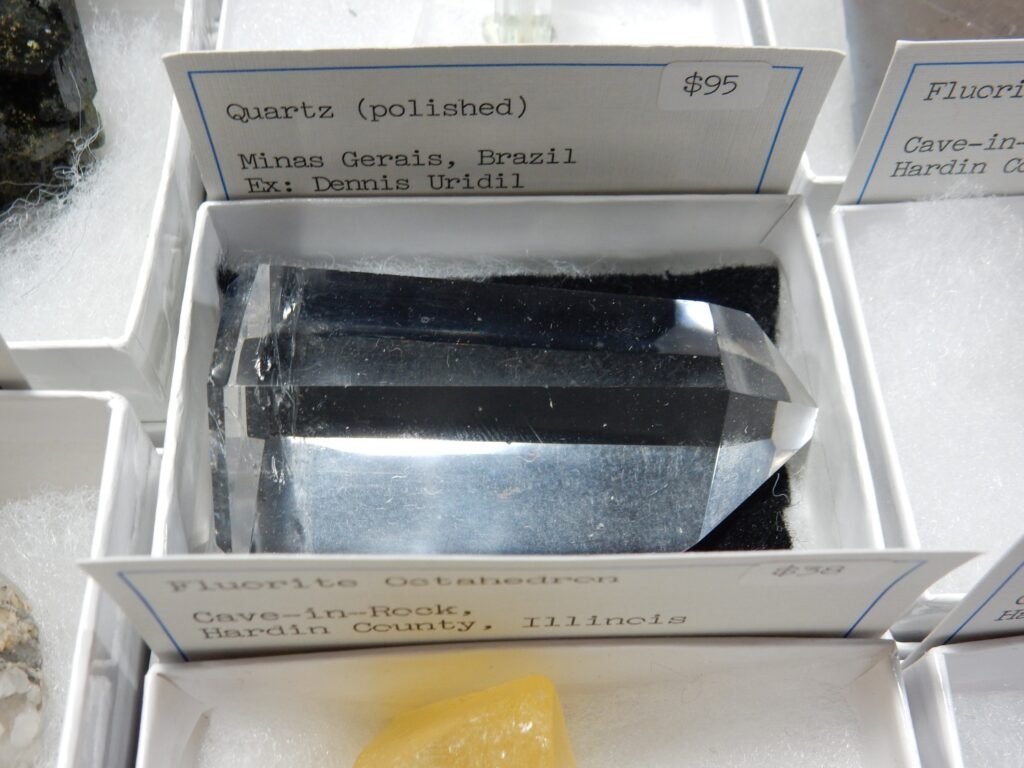
It was likely worth even more when quartz was in demand for electronics. The development of hydrothermal growth of artificial crystals in a factory provided a much less expensive supply for electronics, but of course the synthetic crystals are of much less interest to collectors.
Ruby zoisite.

The green is the zoisite, an epidote mineral. The red really is ruby, in the sense that it is corundum colored by traces of chromium. However, it’s quite low-grade. Nonetheless a valuable collector’s rock, which can also be polished to make a beautiful stone.
Garnet in graphite.
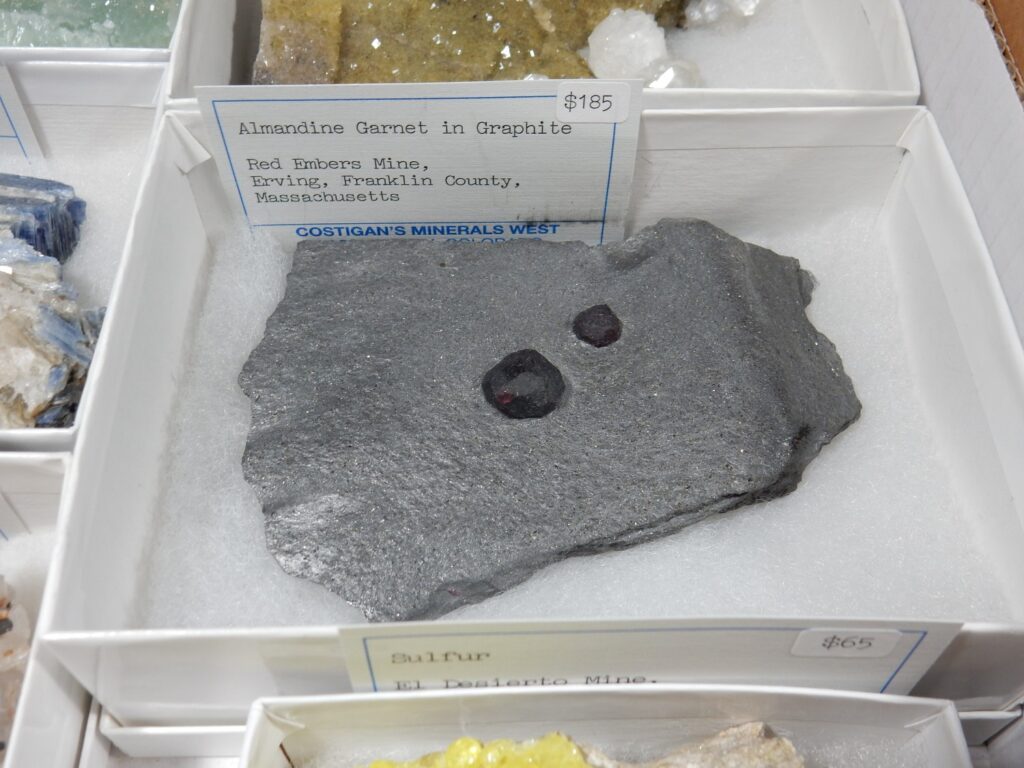
Geodes.
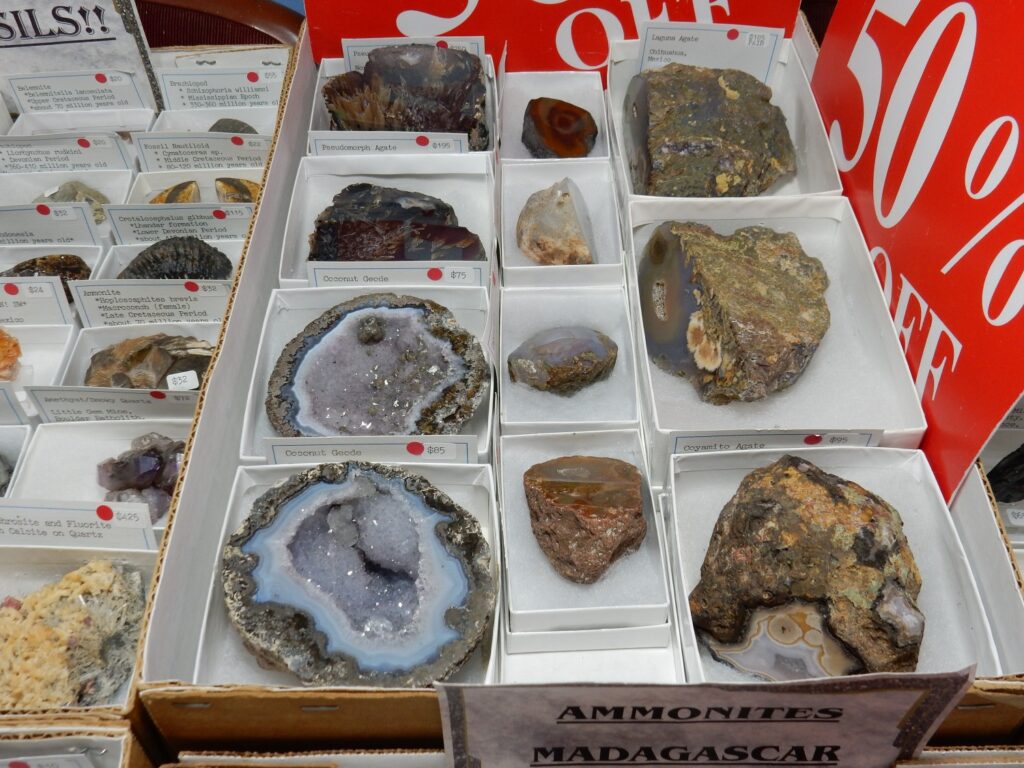
I have severy quite good geodes given to my by my uncle when I was a child. From the Dugway beds in Utah. They are a bit larger than the ones here, though more coarsely crystalline, and would probably sell for a similar price. Not that they’re on the market.
Sliced ammonite fossils.
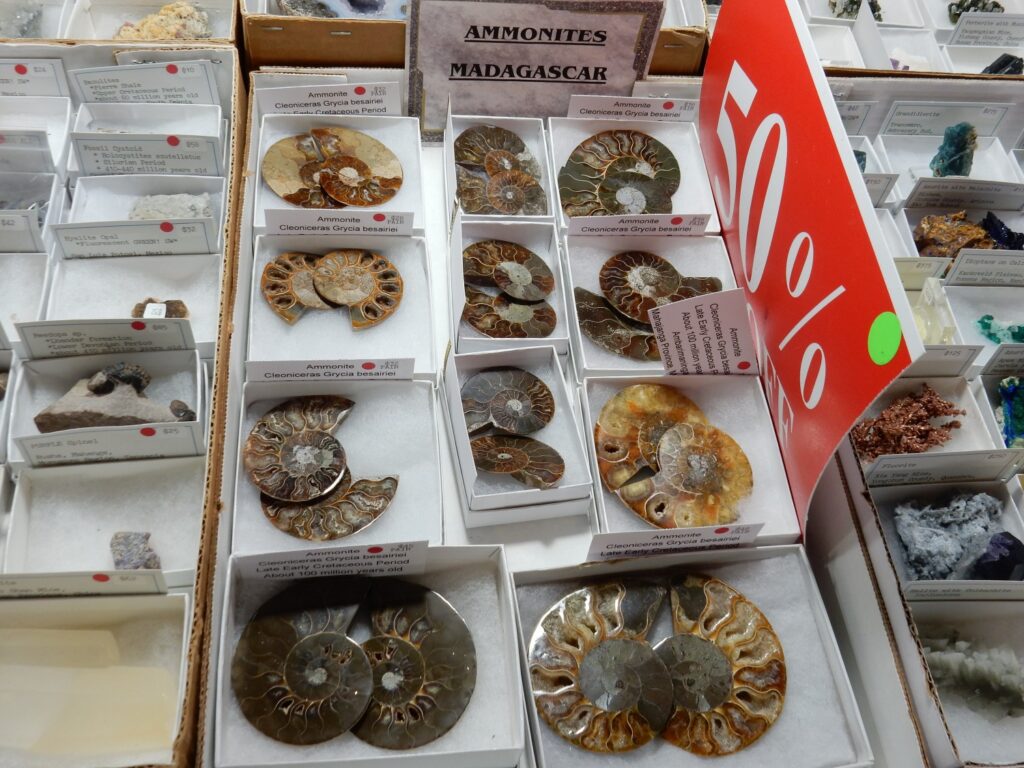
Ammonites were extinct relatives of squid and octopus, differing in having an external shell looking for all the world like a ram’s horn. They’re quite common in some Cretaceous beds, but these have been nicely prepared to show the internal structure. It looks like these are being sold as earrings.
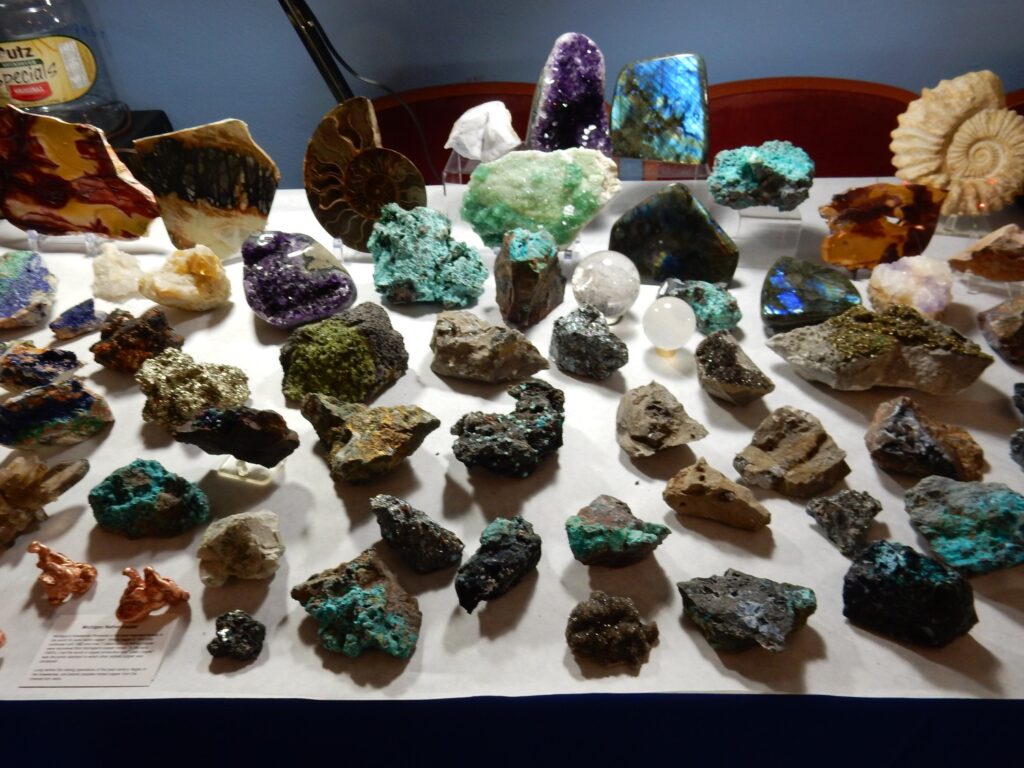
This is one of the largest polished tiger’s eyes I’ve seen. Wish it had focused better.
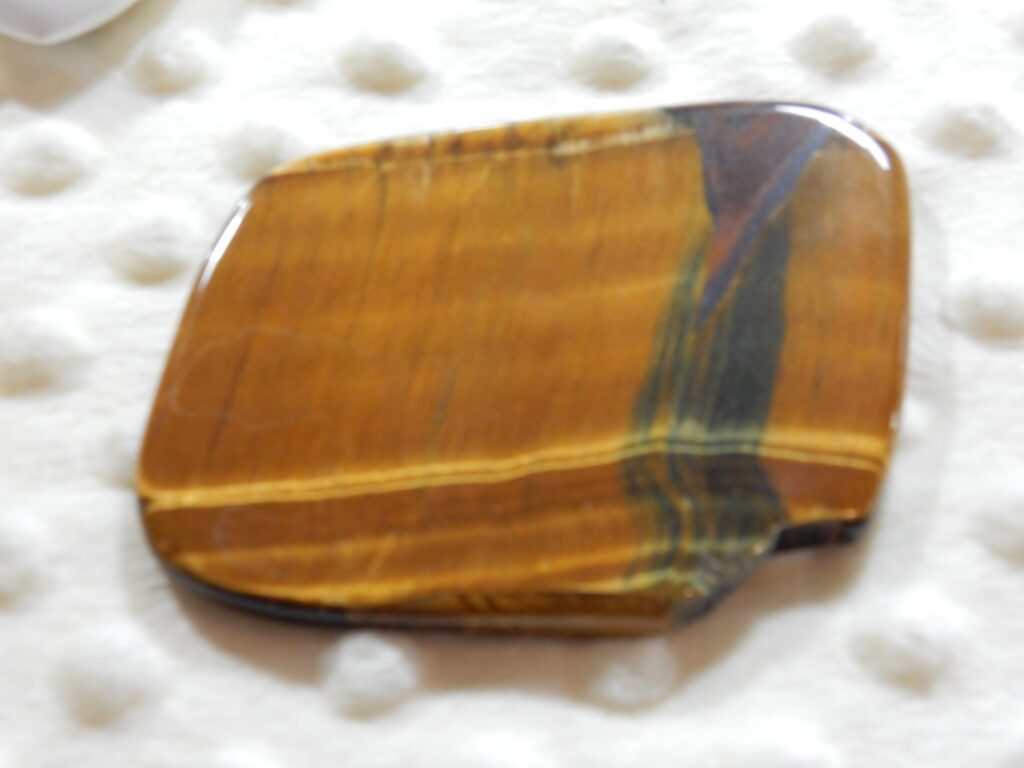
Tiger’s eye is quarts with strands of iron or titanium oxide crystals that form the striations. It seems to be a product of mild metamorphosis of chert, and is not terribly rare — but like most minerals, a really good specimen commands a good price.
Close to a museum piece.
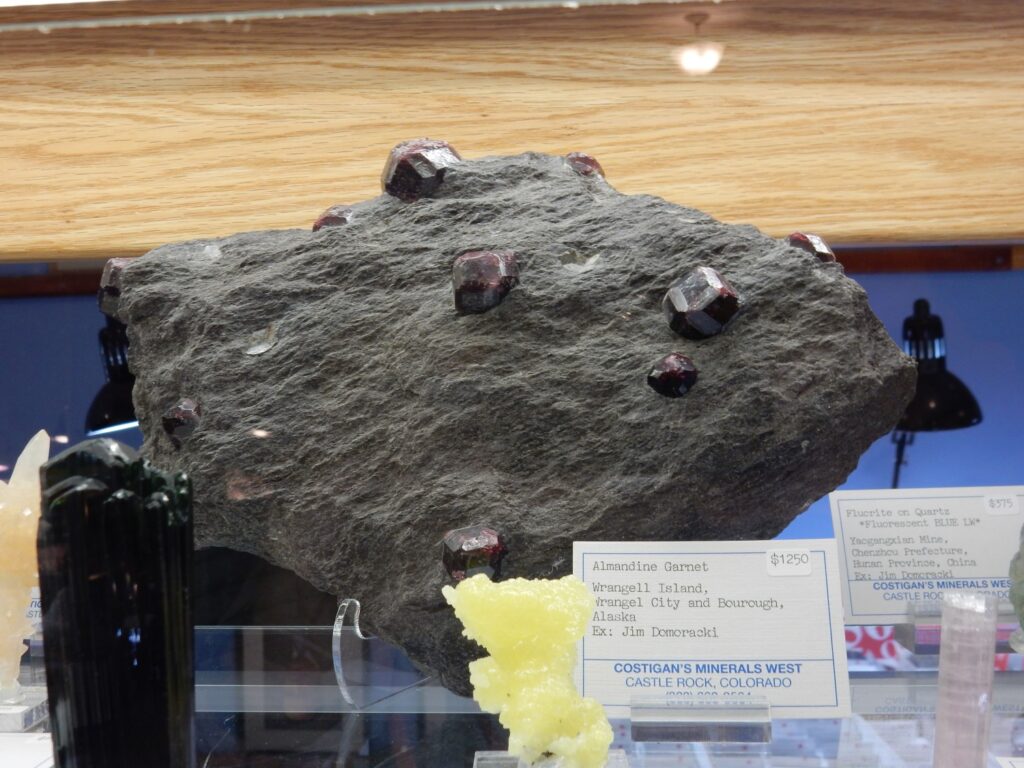
And priced accordingly.
I have a staurolite slab that is the closest thing to a museum piece in my collection. However, while I’ve done some preparation on it, it would require considerable additional preparation to bring it to its full potential. I may have to take time to do that someday.
Halite and sylvite.
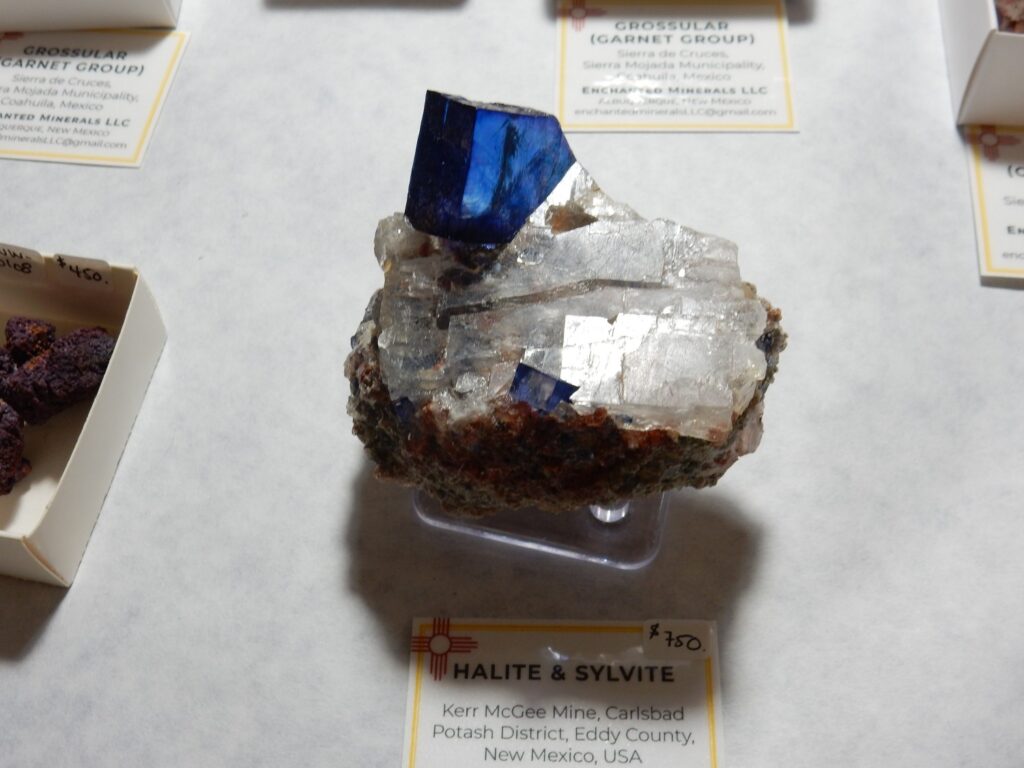
Literally rock salt. But magnificently crystallized, and the blue color indicates the crystal has experienced radiation damage — probably from its own internal potassium, a very mildly radioactive element.
Fine jewelry.
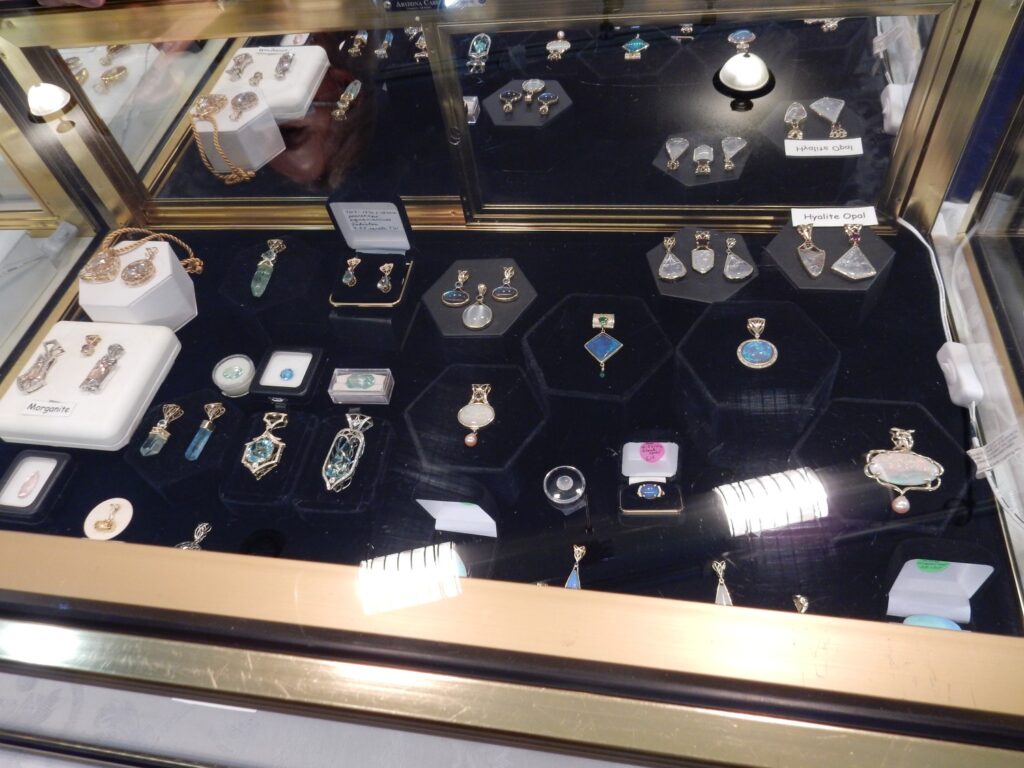
If I were to get Cindy something really expensive, it would probably be a fire opal from this vendor.
Lotsa turquoise.
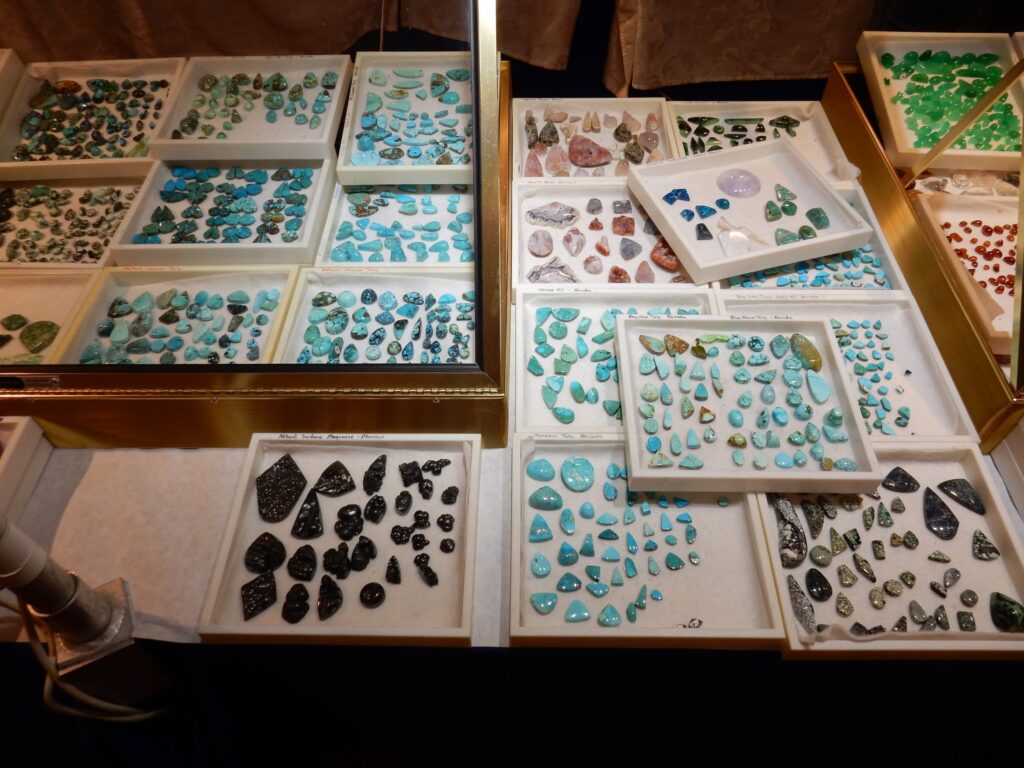
Good turquoise is possibly the most valuable of the “opaque jewels”, jewels that are prepared from crytocrystalline masses rather than individual crystals. It’s a fairly rare copper aluminum hydrated phosphate, formed where hydrothermal veins deposit the mineral from fluids rich in both copper and phosphate. It’s a so-called supergene mineral, formed where a primary copper ore (usually a sulfide) is oxidized by fresh groundwater. Forming turquoise requires a rare combination of oxidized copper, phosphate, and suitable depositional conditions.
Alkali beryl.
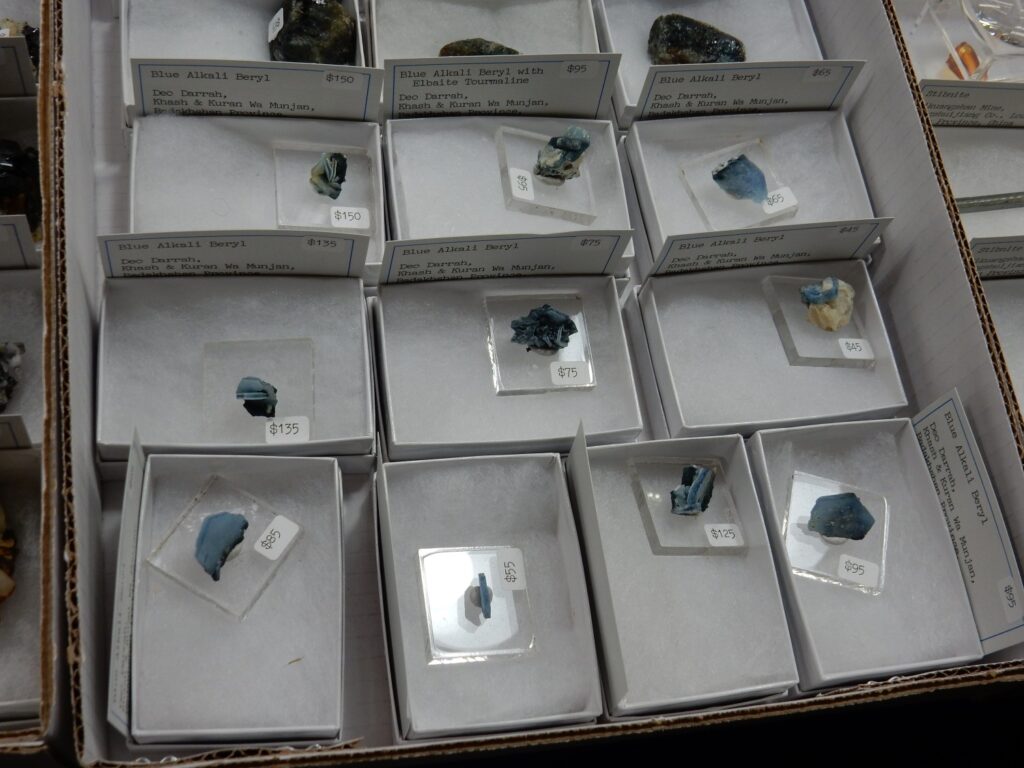
Rick Kelley informs me that this is a form of beryl enriched in lithium and caesium.
I’ve purchased a couple of items (photos later) and my shift is now on. I put on the yellow security vest and start wandering around. No need to go into details, but security patrol is mostly a matter of presence; having my camera handy actually is beneficial. (If a vendor fingered someone as having pocketed an item, the first thing I would do would be to take a photograph of the suspect. Fortunately the need did not come up.)
More non-mercantile displays in the corridors.
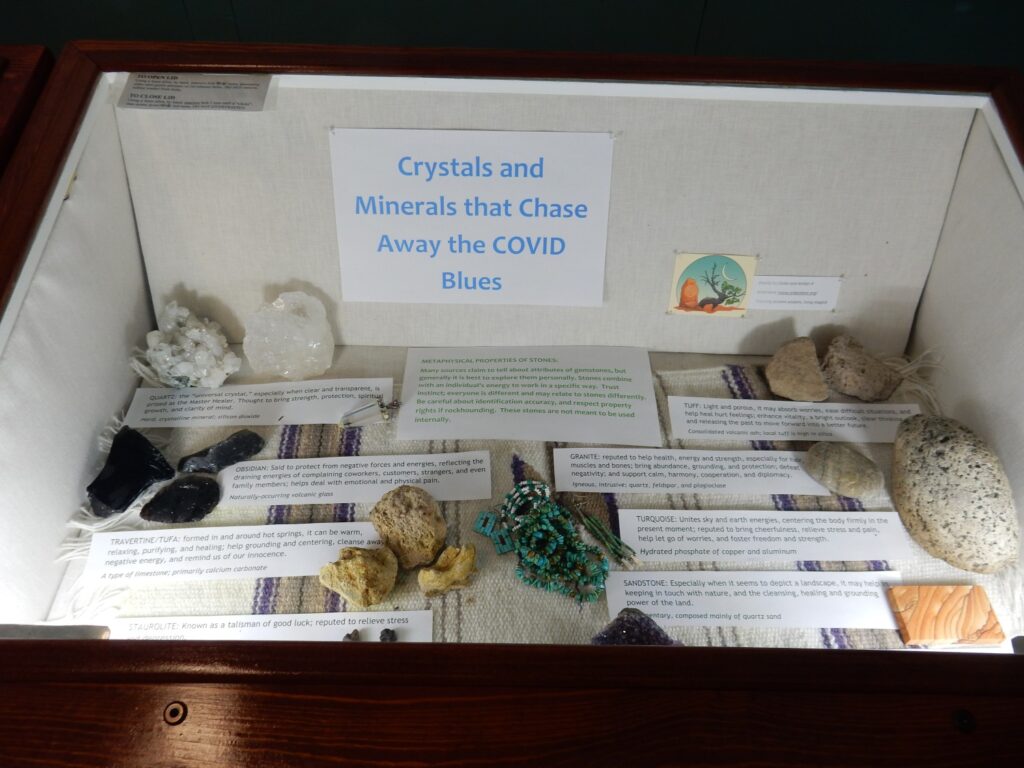
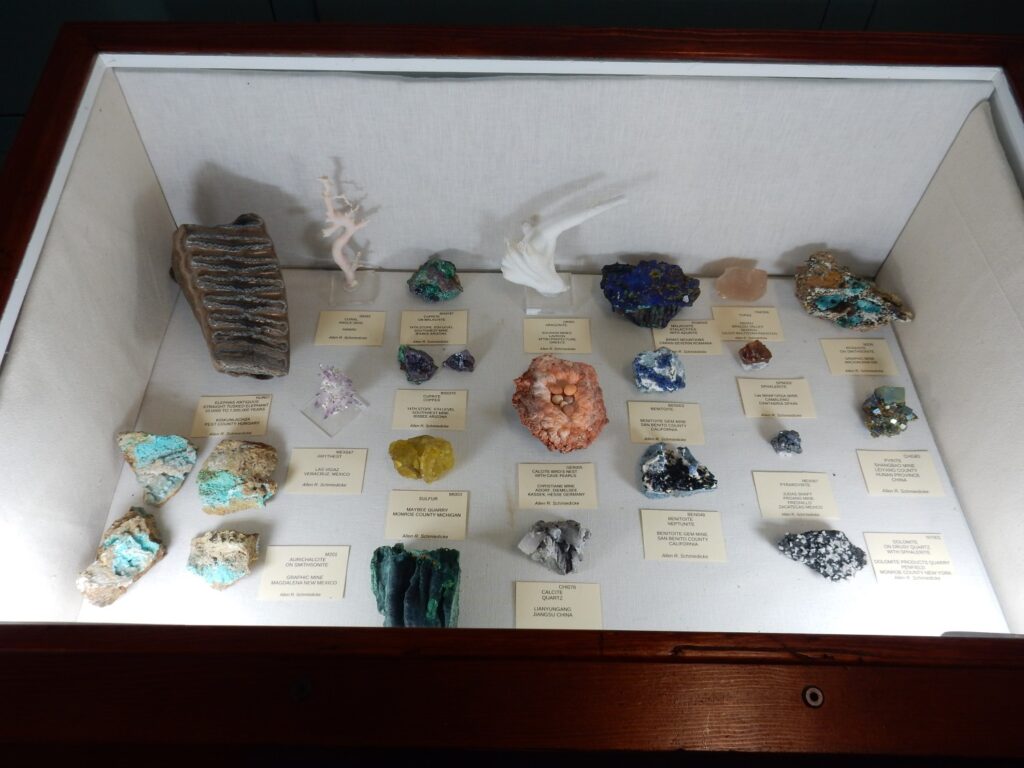
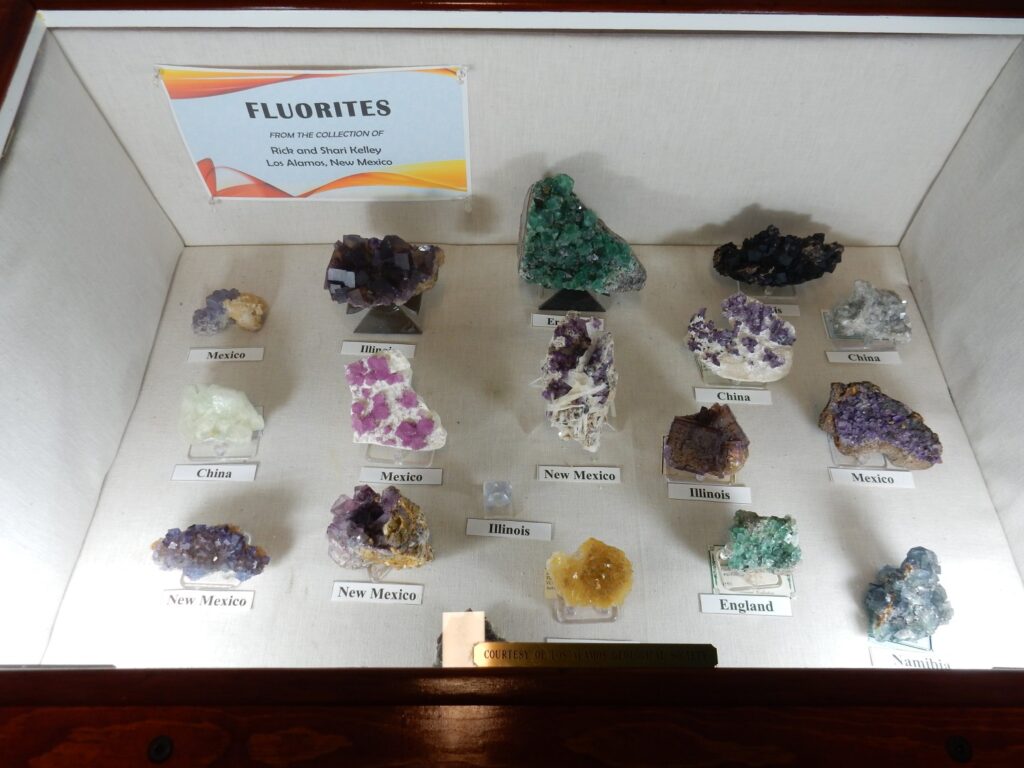
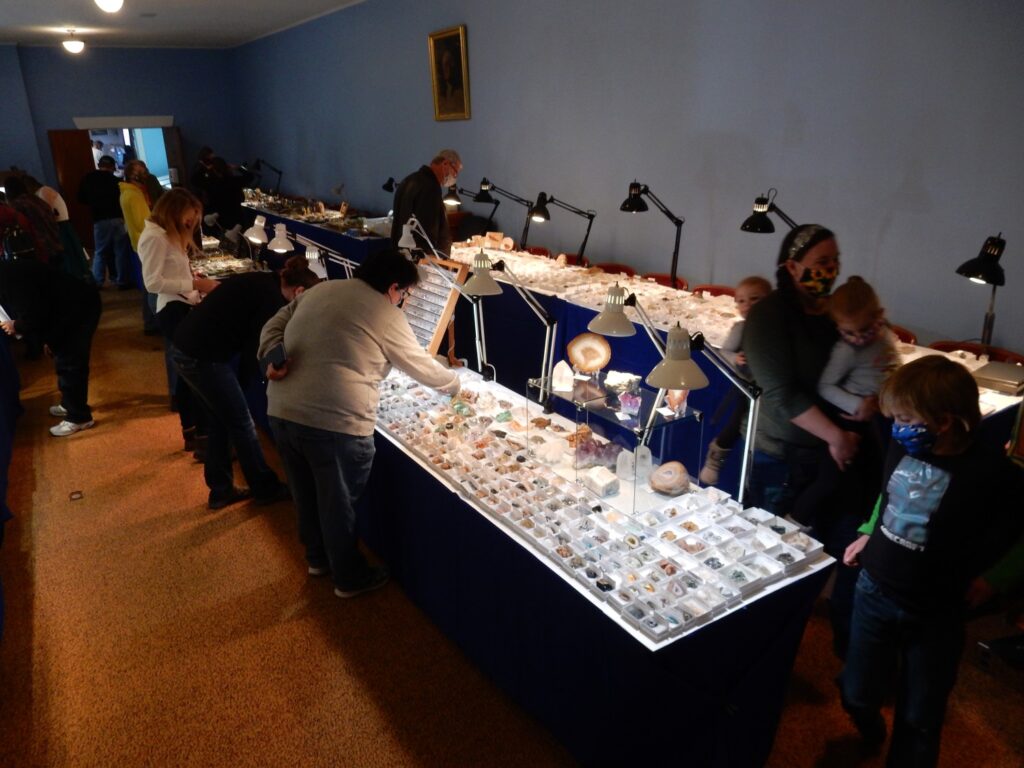
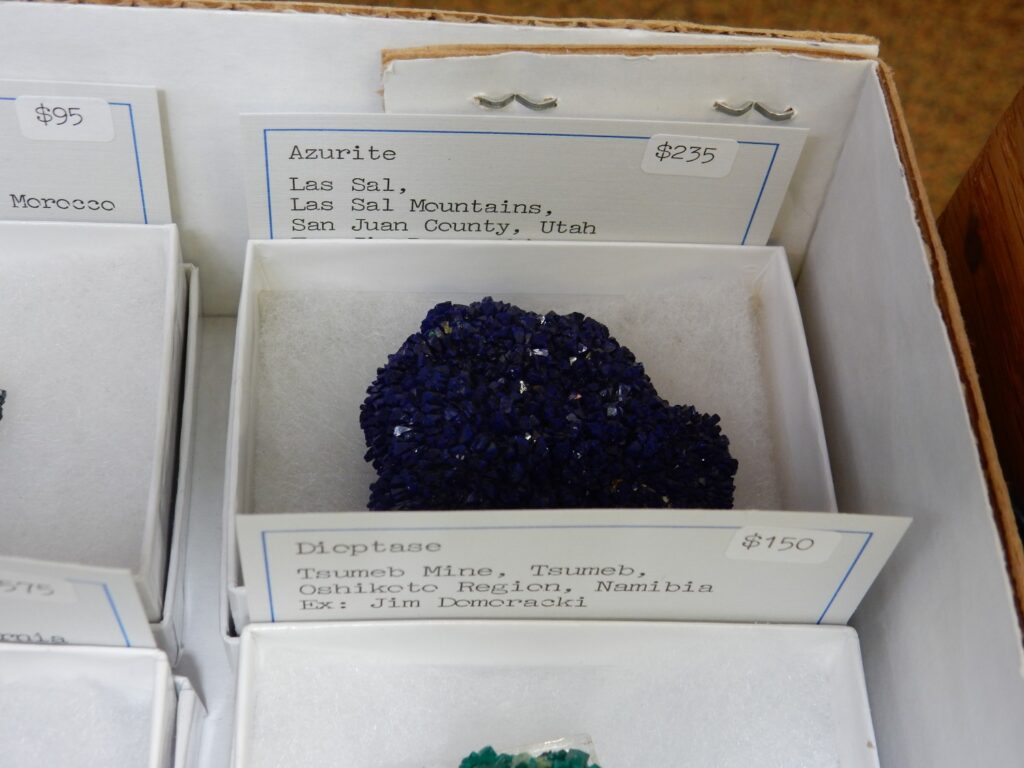
Silent auctions are taking place every 20 minutes. The rocks are put out; you sign a bid on a sheet if you are interested; the proceeds go to our scholarship fund for geology students to attend the Fall Field Conference of the New Mexico Geological Society. I got a nice piece of fluorescent franklinite, but I missed out on this beauty:
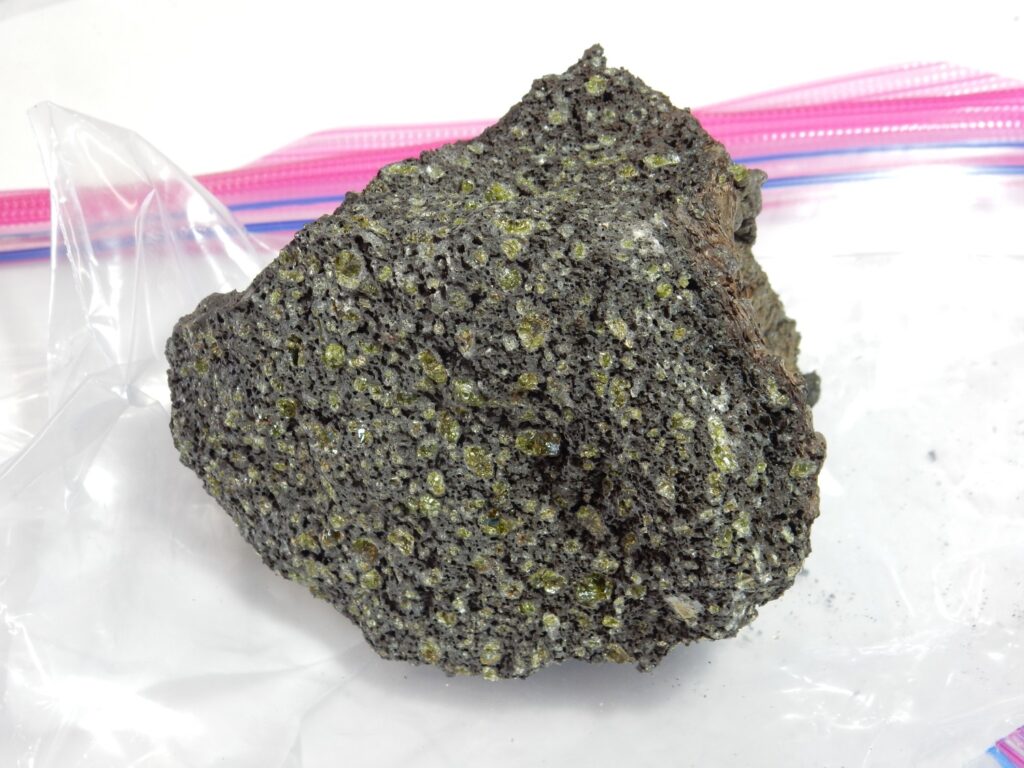
Picritic basalt (basalt choked with olivine crystals) from Maui. I wasn’t willing to go as high as the other guy.
So what did I snag?
Ulexite:
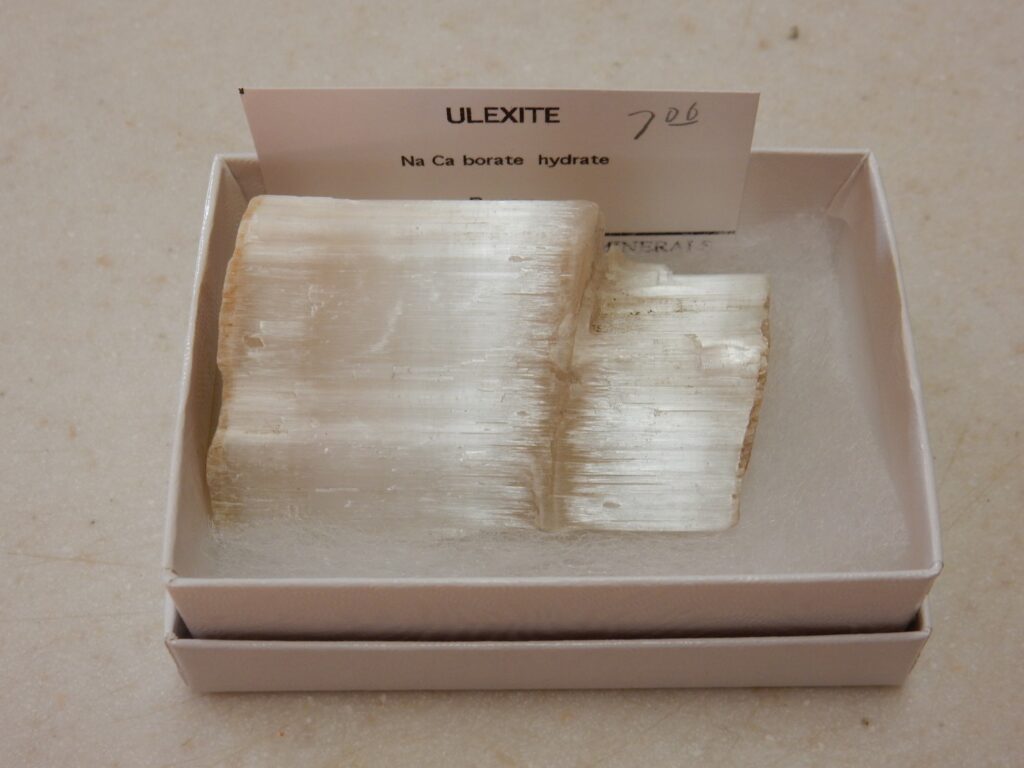
Ulexite is sodium calcium borate, and its fibers transmit light in such a way that it has sometimes been described as natural optical fiber. I am tempted to take part of this sample and polish both ends, to show this effect.
A baculite.
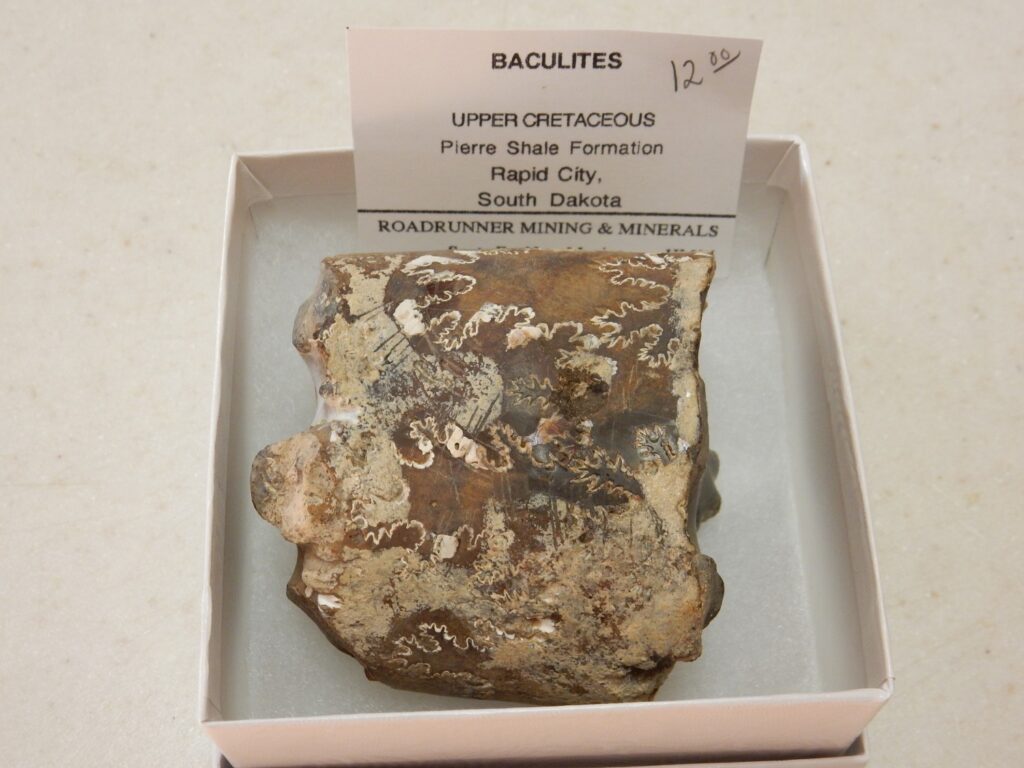
I know. I collected some of my own a couple of months ago. This one shows the sutures better than anything I’ve collected myself. Sutures are where separate sections of the critter’s shells joined.
Franklinite.
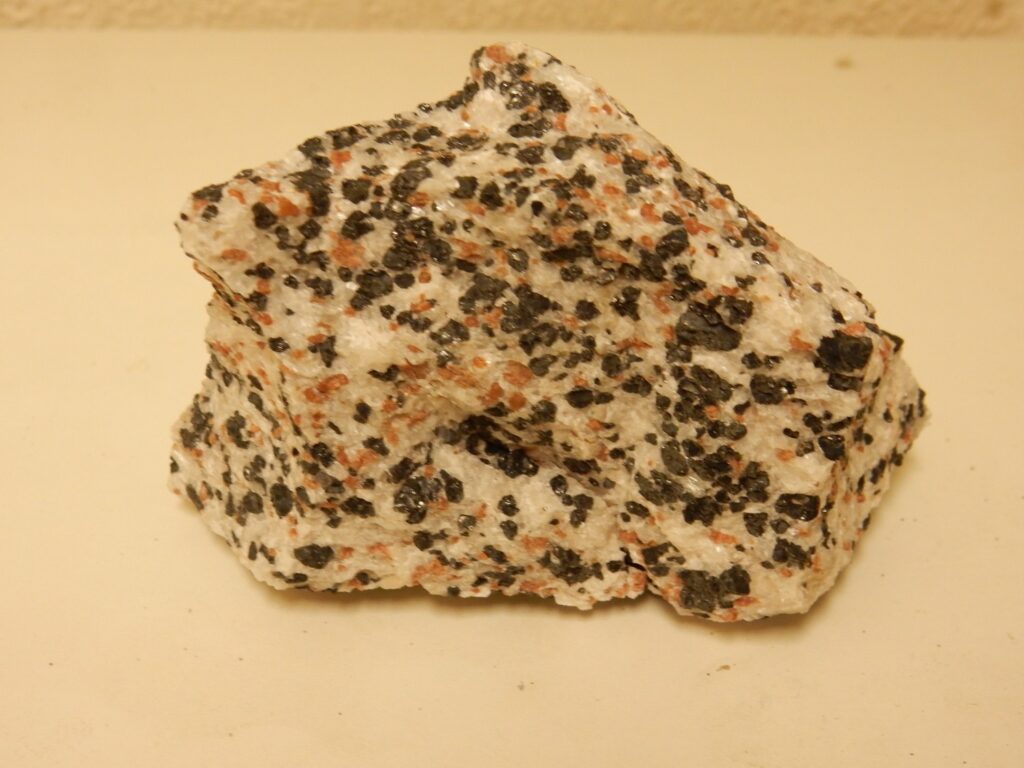
Or, to be more precise: Black crystals of franklinite, a zinc/iron oxide mineral that is a minor ore of zinc, embedded in white calcite, with reddish crystals of zincite (zinc oxide) and a very few scattered crystals of willemite, zinc silicate.
It may not look like much until you shine shortwave ultraviolet on it.
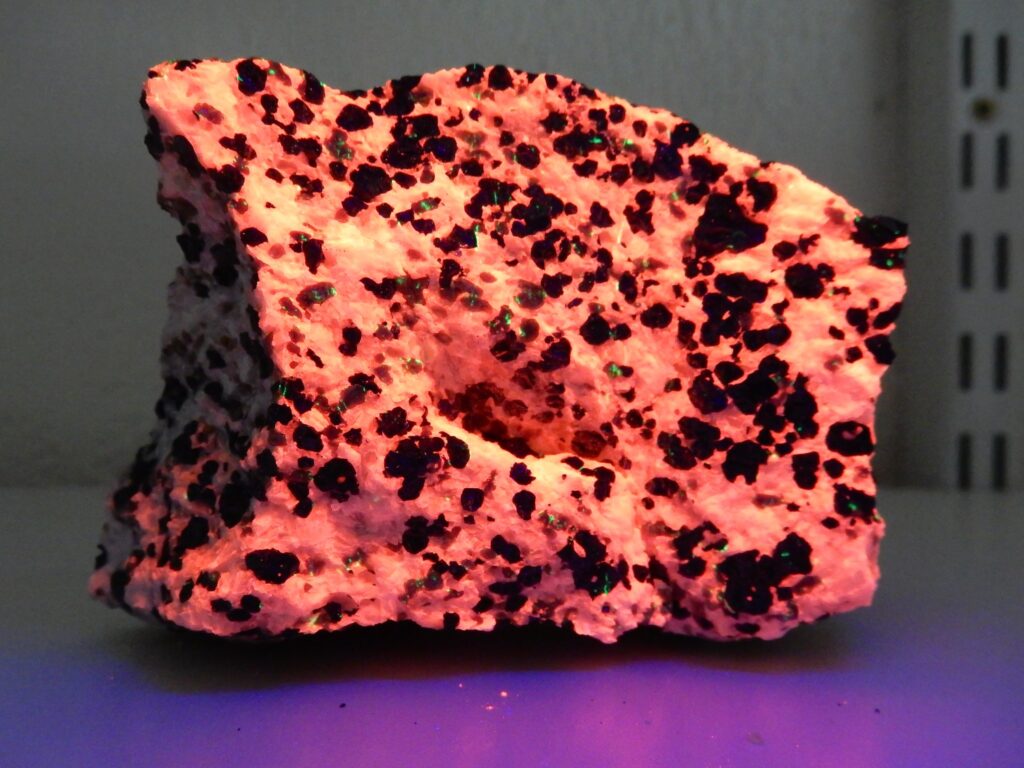
The calcite glows bright orange-red. The few scattered crystals of willemite glow green.
Lots of calcite fluoresces red, but this particular calcite chock-full of zinc, from the Franklin mine in New Jersey, is famous for its spectacular orange-red glow.
This caught my eye badly enough to cost me.
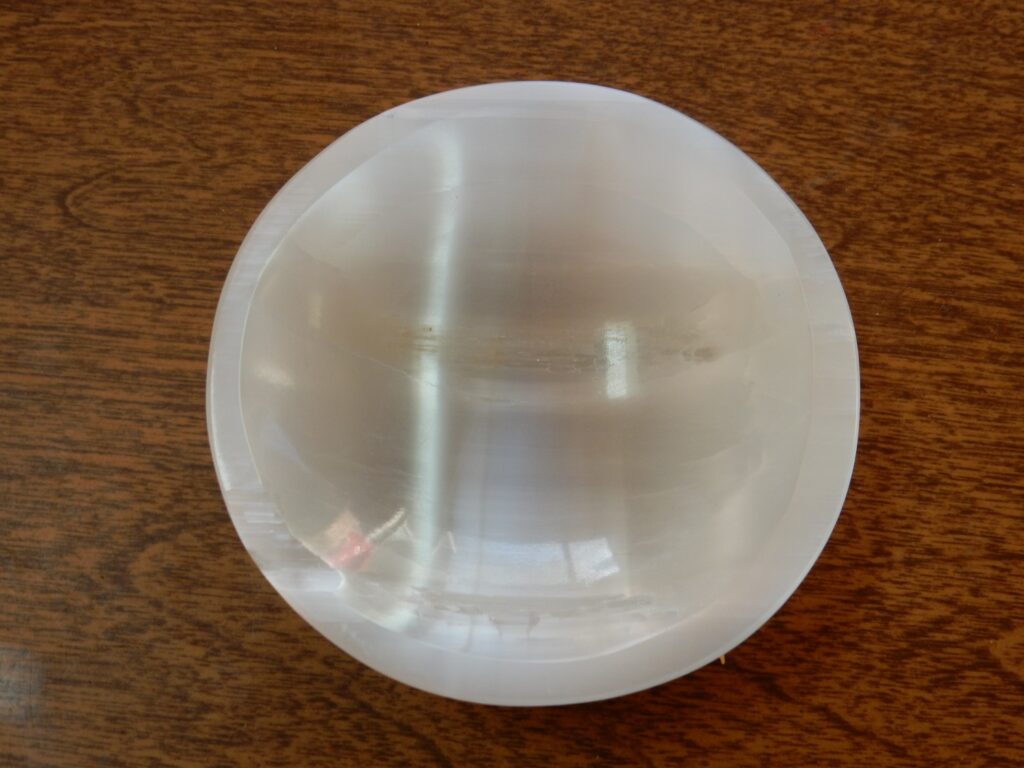
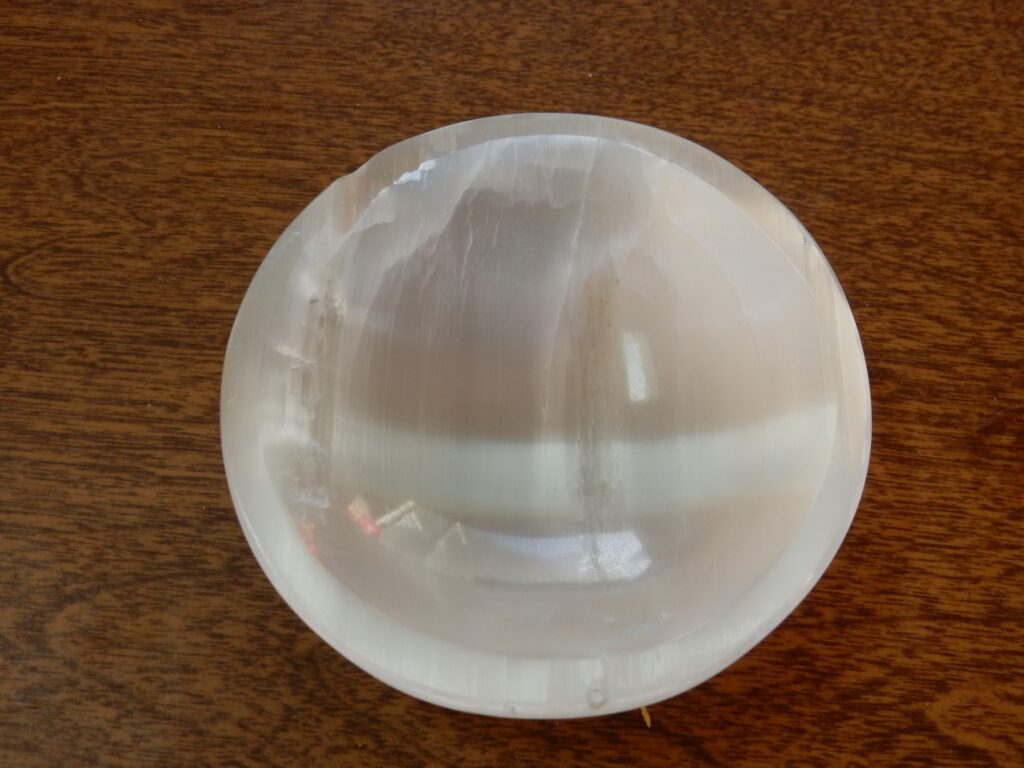
This a small bowl carved out of a single crystal of selenite, calcium sulfate. Or so it was labeled; selenite is very soft, but this bowl seemed rather harder than that, so I suspect it is some other fibrous calcium mineral — possibly satin spar, a form of calcite. The optical effect is striking; the bowl appears to be turned inside out when viewed from some angles
Just down the block is the annual creche show of the Latter-day Saint ward I grew up in.
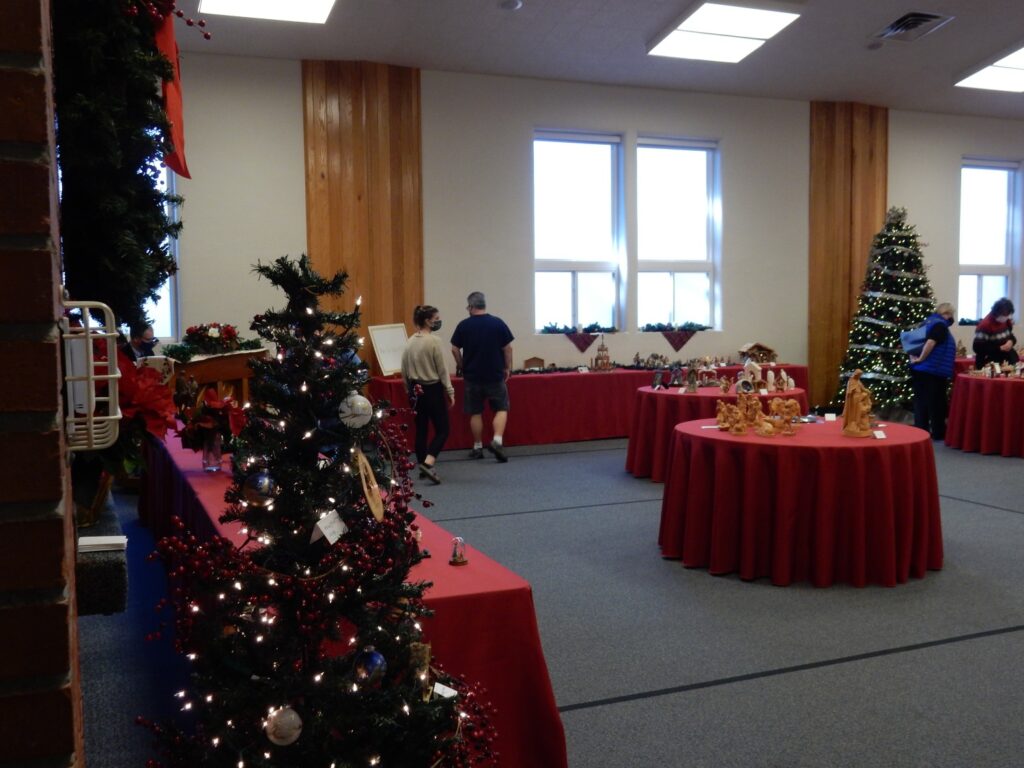
I particularly like some of the foreign creches.
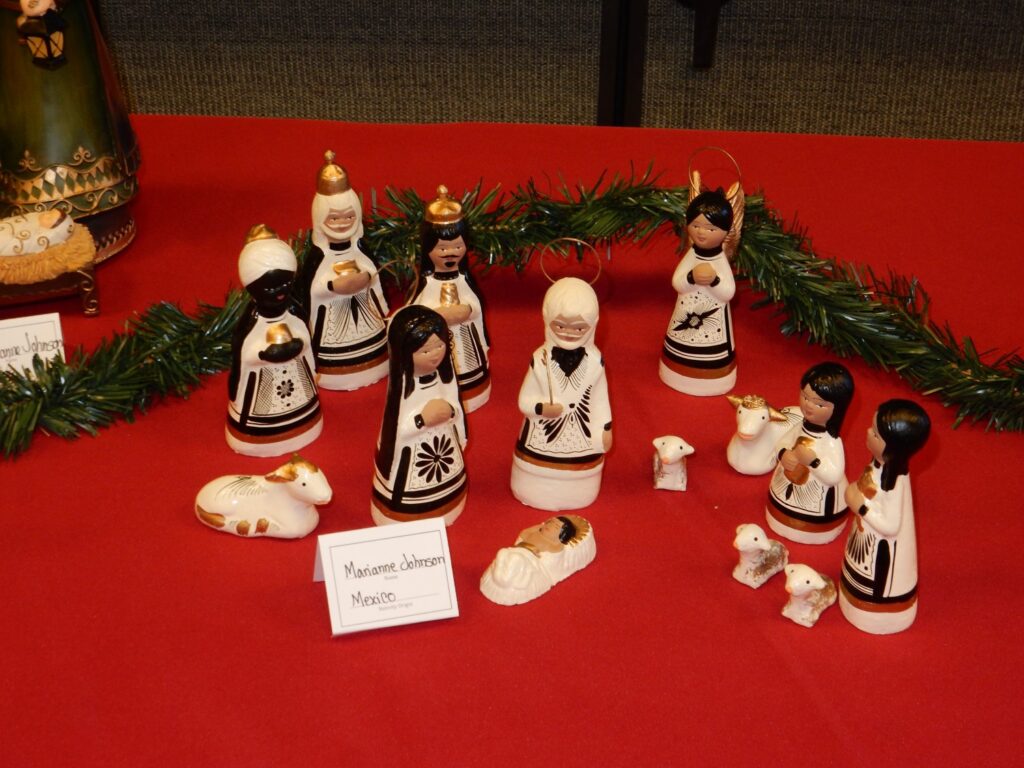
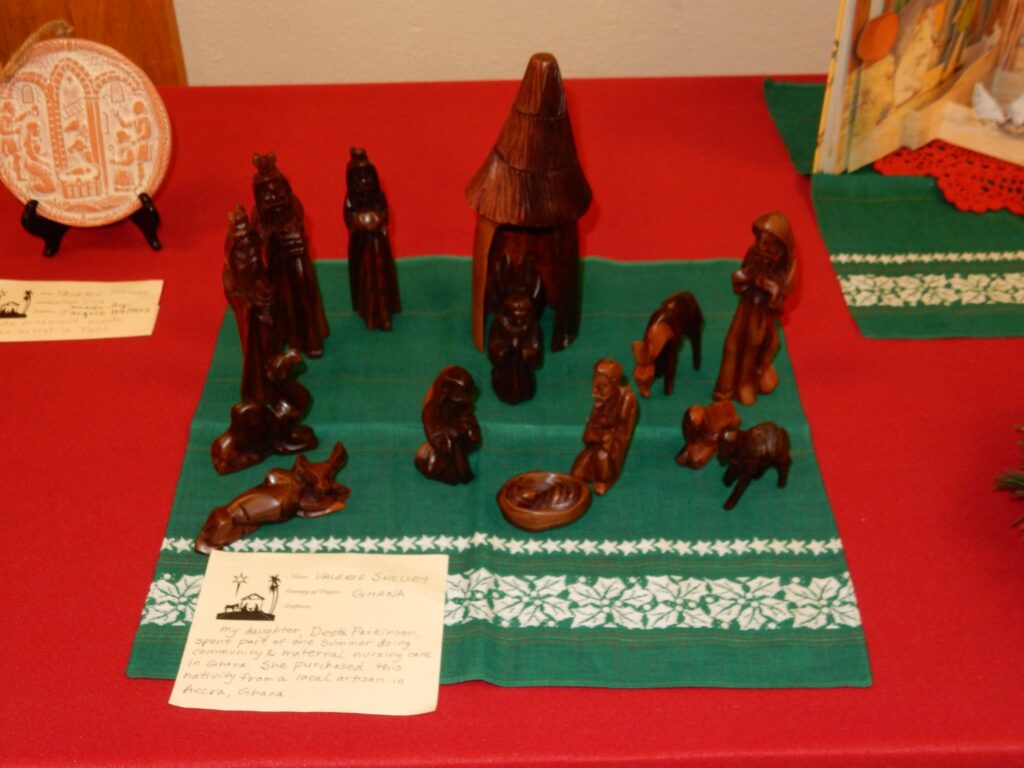
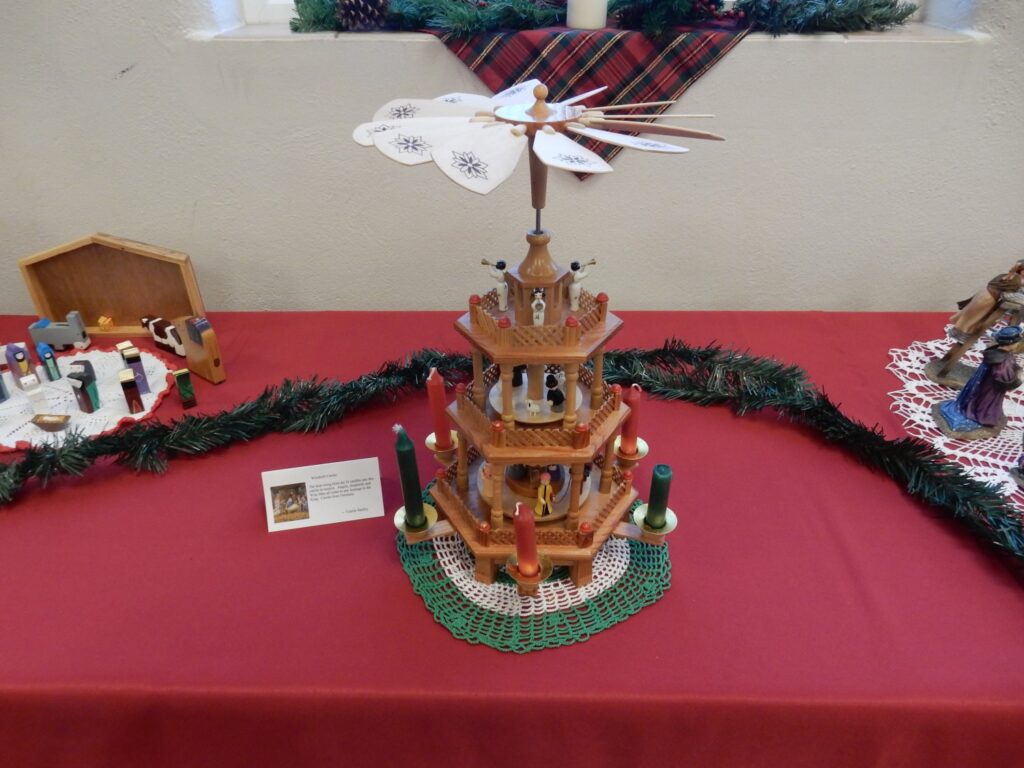
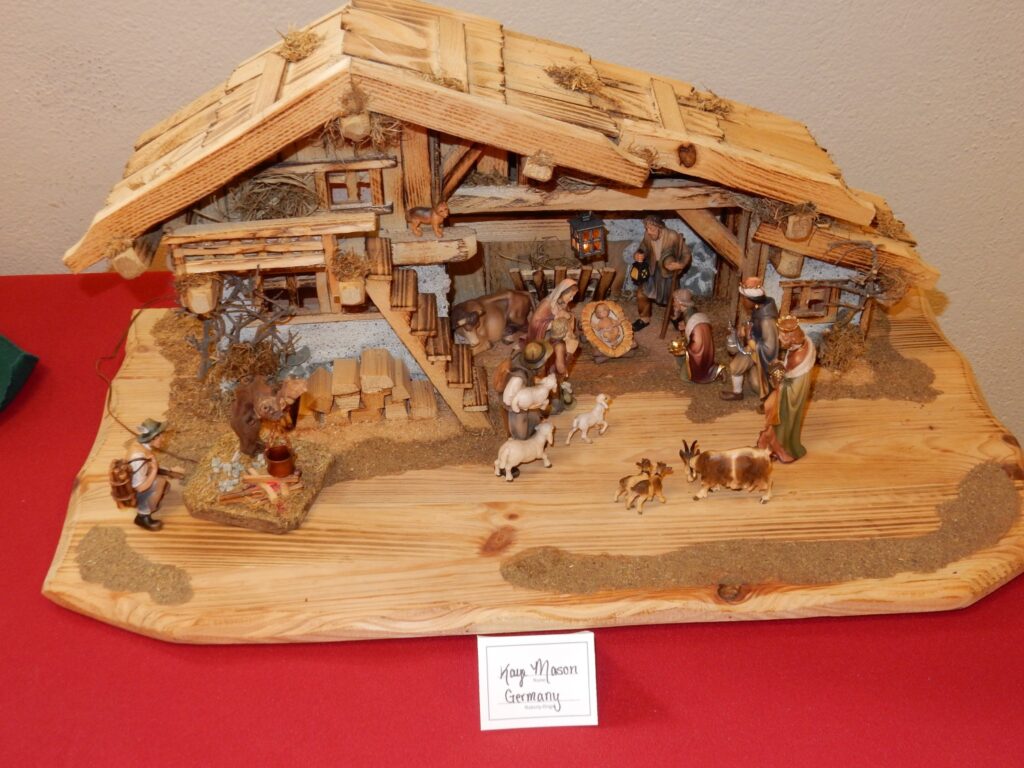
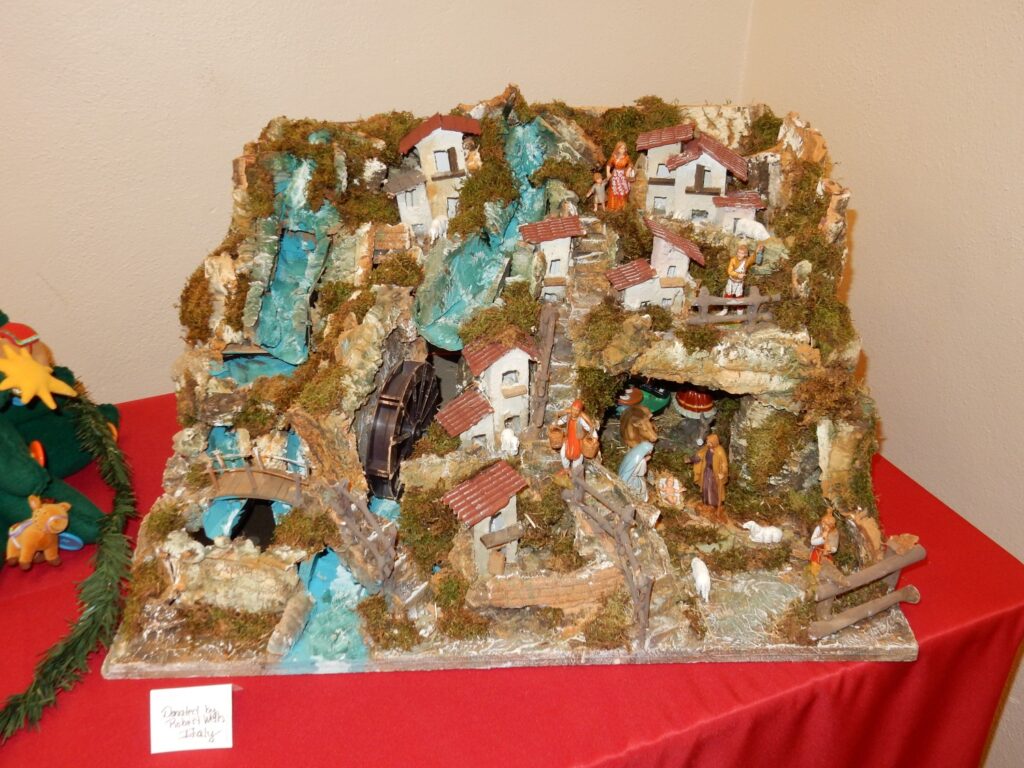
Merry Christmas to you all.
